68 Of the Best Tourist Attractions in Northern Ireland
Visiting Northern Ireland and looking for something to do beyond Belfast; or want to take some day trips from Belfast? There is so much to see and do outside of the City limits and beyond the magnificent Causeway Coastal Route but most visitors don’t take the time to visit all of Northern Ireland.
There are many things to do in Northern Ireland and if you have been here before and are hoping to see more of the North past the Giant’s Causeway, Game of Thrones sites and the Carrick-a-rede rope bridge the areas outside of Belfast are well worth taking a look at. A major tourist attraction in Northern Ireland is of course the Titanic Exhibition, but there are many places to go in Northern Ireland and many are off the beaten path of tourism for example you can explore the Ulster Scots history and legacy. Here are 60-day trips you can take from Belfast.
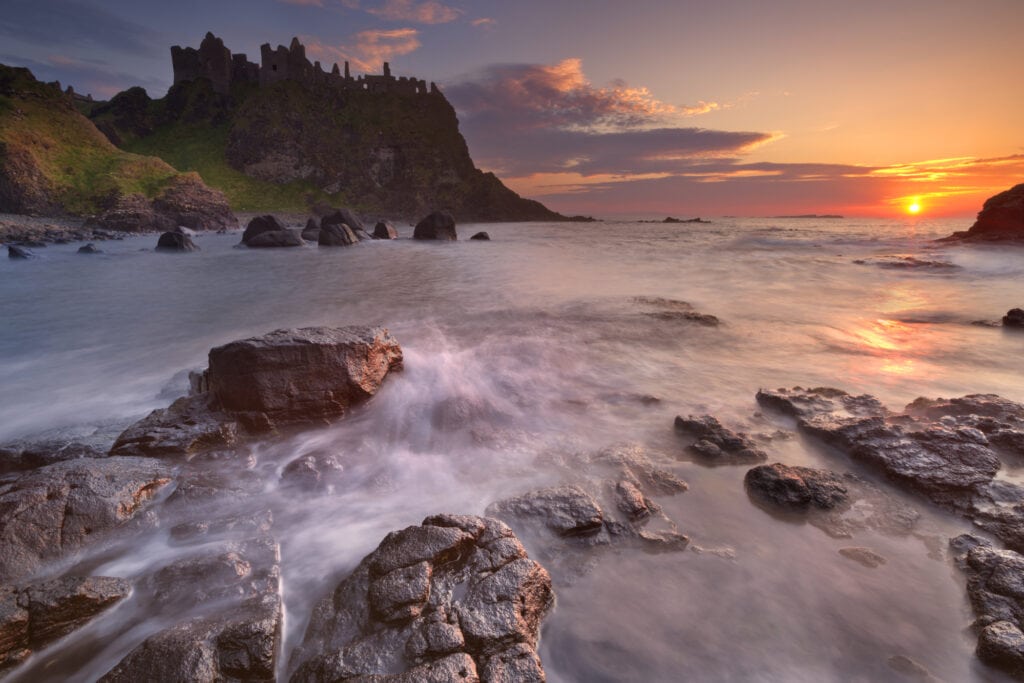
Things to do in Belfast
In Belfast itself, there is a lot to see, visit the Titanic Visitors Experience, hit up the fabulous shopping districts of the Victoria Centre or the bustling city centre shopping street, book your Game of Thrones tour, take a famous black cab tour of the Belfast murals or a Belfast city sightseeing tour.
There are many tours and day trips from Belfast as tourism in Northern Ireland has grown substantially in the last 20 years from castles to nature walks, and neolithic sites there are so many unique things to do in Northern Ireland you will be spoiled for choice.
Northern Ireland Map
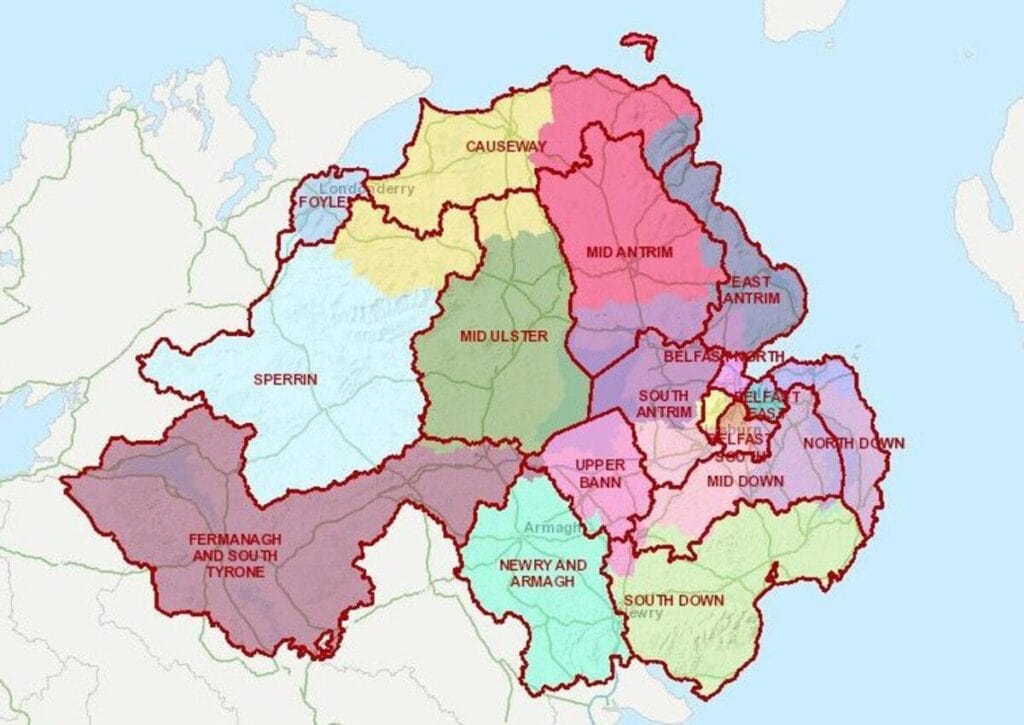
Northern Ireland Tourist Attractions Map
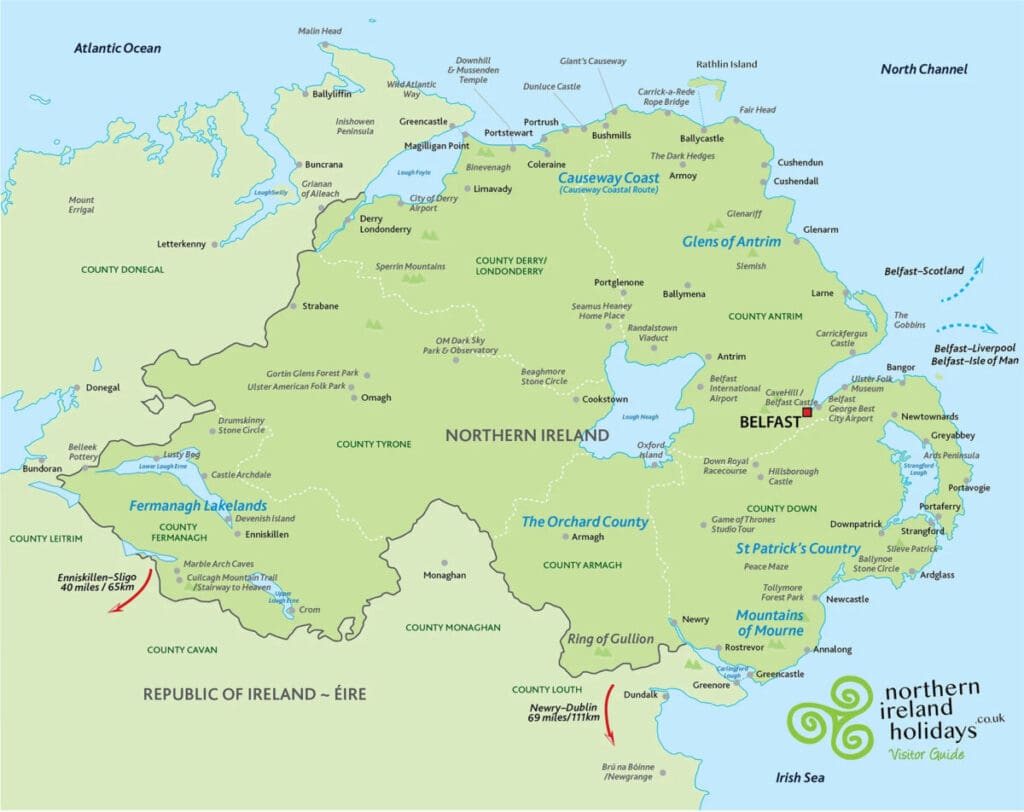
- 68 Of the Best Tourist Attractions in Northern Ireland
- Things to do in Belfast
- Northern Ireland Map
- Northern Ireland Tourist Attractions Map
- Top rated tourist attractions in Northern Ireland
- 68 Things to Do in Northern Ireland
- Belfast – Crumlin Road Gaol
- Titanic Belfast
- Belfast Castle
- Castle hotels in Northern Ireland
- Folk Museums in Northern Ireland
- Neolithic Sites in Northern Ireland
- Places to see in Northern Ireland
Xyuandbeyond is reader-supported. When you buy through links on our site, we may earn an affiliate commission. You can read my privacy policy here.
Top rated tourist attractions in Northern Ireland
If you don’t rent a car and want to tour Northern Ireland personally, one of my favourite and highly recommended tour companies is Wild Rover Tours. The company does tours from both Dublin and Belfast along with private tours designed to your schedule and bucket-list sites.
If you are travelling with kids and looking for things to do in Northern Ireland you will find plenty of things to keep them occupied from castle ruins to heritage sites like the Giant’s Causeway and outdoor activities from farm visits to adventure centres.
68 Things to Do in Northern Ireland
Landmarks in Northern Ireland
There are probably hundreds of castle ruins many of which are haunted in Northern Ireland and if you rent a car and drive around the countryside you are bound to stumble across ones that you never heard of. Stop and take in the sights and sounds of these ruined castles and hauntingly beautiful sites you won’t be sorry.
Belfast – Crumlin Road Gaol
One of the top tourist attractions in Belfast is the Crumlin Road Gaol. In 1996 the Crumlin Road Gaol finally closed its infamous doors. These days a guided tour of the Gaol will cost around £9.00 for an online ticket. You will take a guided tour and hear the entire miserable history of the site. Dating to its early days in the 1800’s up to the days in the 90s when the prison contained both Republican and Loyalists prisoners.
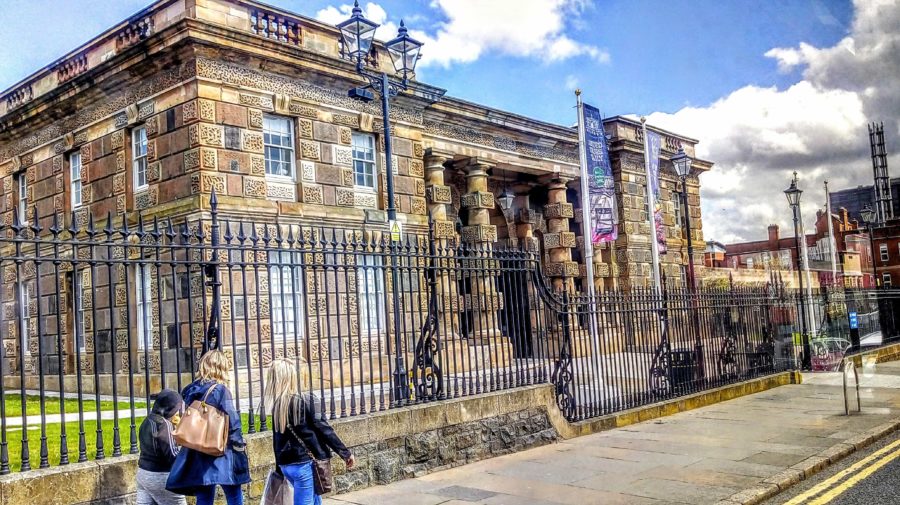
Titanic Belfast
One of the places to see in Belfast is the Titanic Museum and it is considered one of the must-see attractions in Belfast. I am not a Titanic fan per se so I really didn’t bother to go and see the Titanic Experience although I hear it is just amazing. Having said that I understand that the interactive displays and exhibits are not something that interest me. What fascinated me was the fabulous Afternoon Tea held on Sundays in a replica of the Titanic’s grand Salon including that amazing staircase.
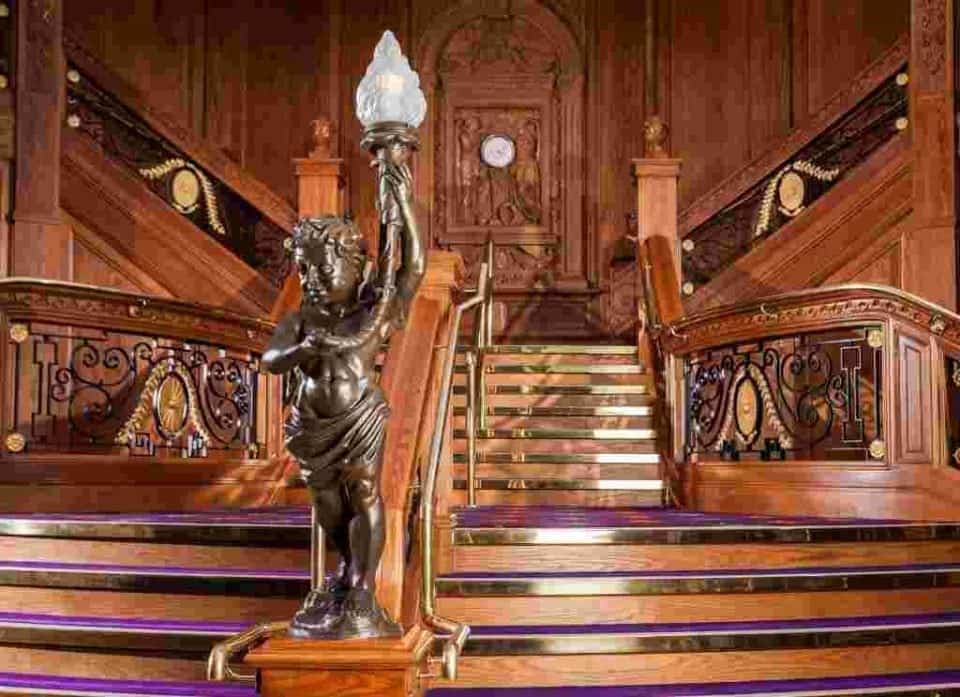
Belfast Castle
One of the best places in Belfast for a view of the city is from Cave Hill, a basaltic hill overlooking the city and where Belfast Castle is located in the Cave Hill area of north Belfast. It was built in the 1860s and is one of the city’s most famous landmarks. The location of the castle is named after the five caves located on the side of the cliffs. Cave Hill’s most famous feature is called Napoleon’s Nose, and it is believed to have been the inspiration for Jonathan Swift’s novel, Gulliver’s Travels.
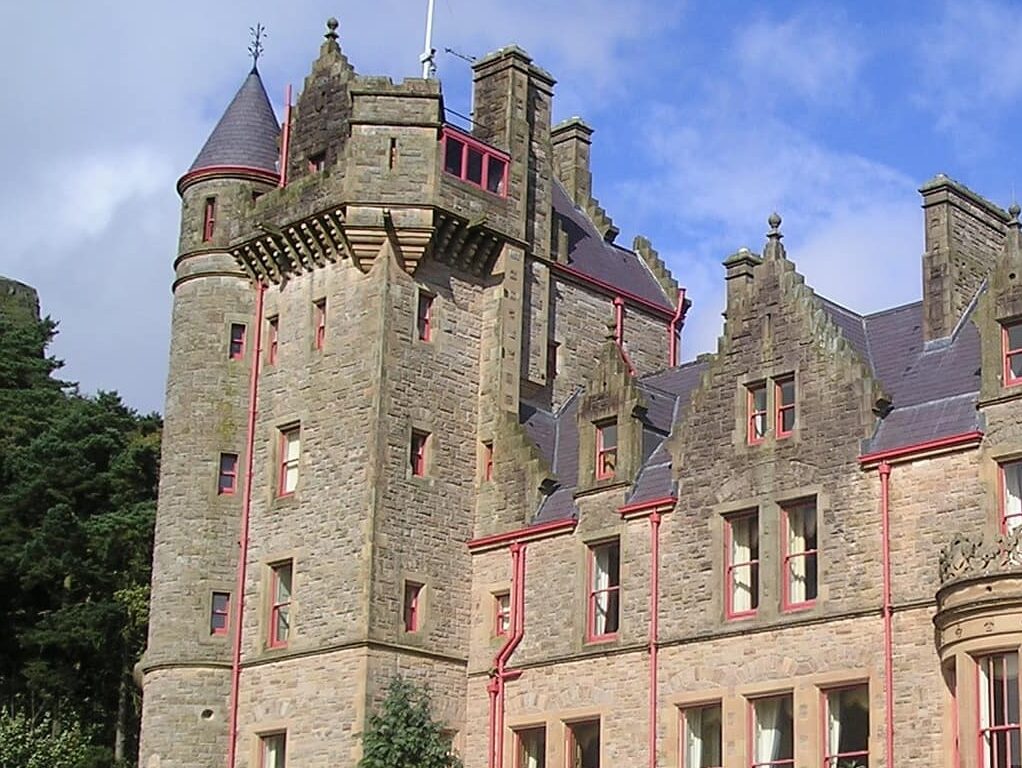
Entrance to the grounds and the castle are free and you can wander around at your leisure – take a camera the views are stunning. The park is home to the Cave Hill Adventurous Playground, archaeological sites, eco-trails, walking and orienteering routes.
Enniskillen Castle
Enniskillen situated beside the River Erne in County Fermanagh was built almost 600 years ago by the ruling Gaelic Maguires. Guarding one of the few passes into Ulster, it has been strategically important throughout its history. Today, the historic site houses two museums, Fermanagh County Museum and The Enniskillen Museum.
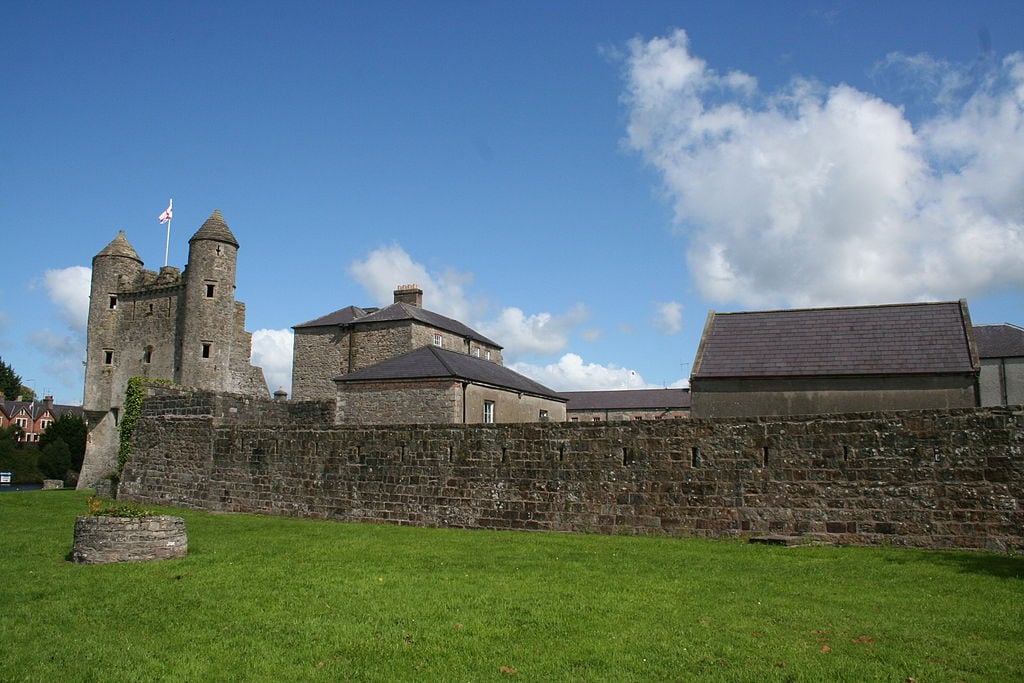
Carrickfergus Castle
Carrickfergus is a Norman castle in Northern Ireland, set in the town of Carrickfergus in County Antrim, on the northern shore of Belfast Lough. Besieged in turn by the Scots, Irish, English and French, the castle played an important military role until 1928 and remains one of the best-preserved medieval structures in Ireland. You can wander the grounds and climb the tower and it’s an interesting castle to visit.
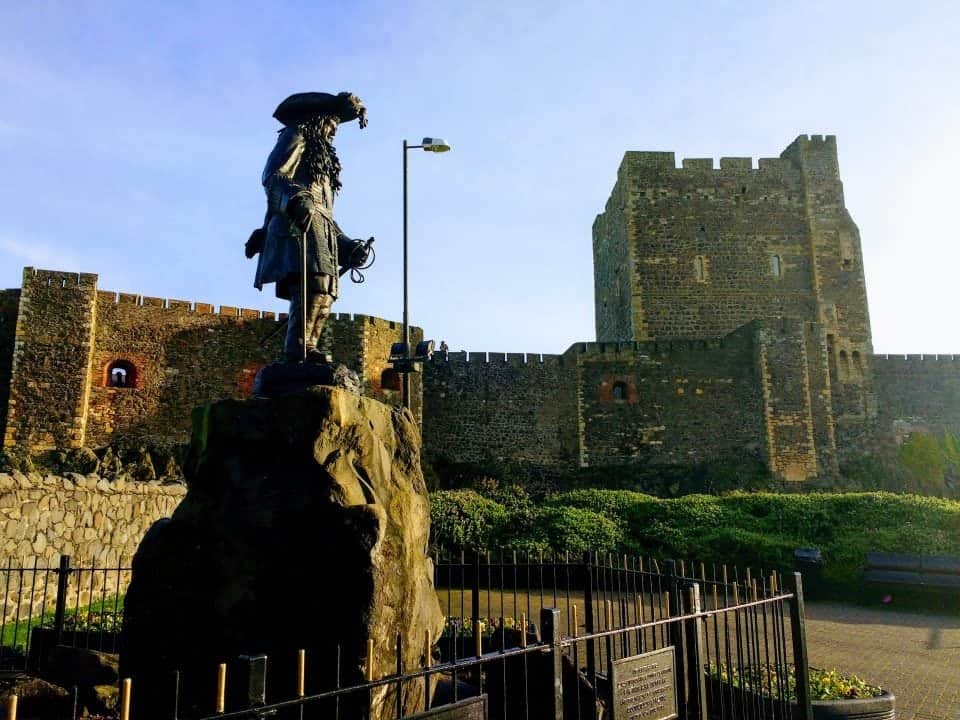
Kirkistown Castle
It is believed that Kirkistown Castle was built by Roland Savage of Ballygalget in or around 1622 and it is debated whether or not there was a castle on the site, on which he built his domain on.
The castle consists of a three-storey tower house within the remains of a bawn (fortified enclosed space) and a later barn. Because the castle was built upon a marsh in the late 19th century buttresses and two iron braces were added to prevent the walls from shifting. The tower was extensively remodelled in a neo-gothic style in the early 19th century.
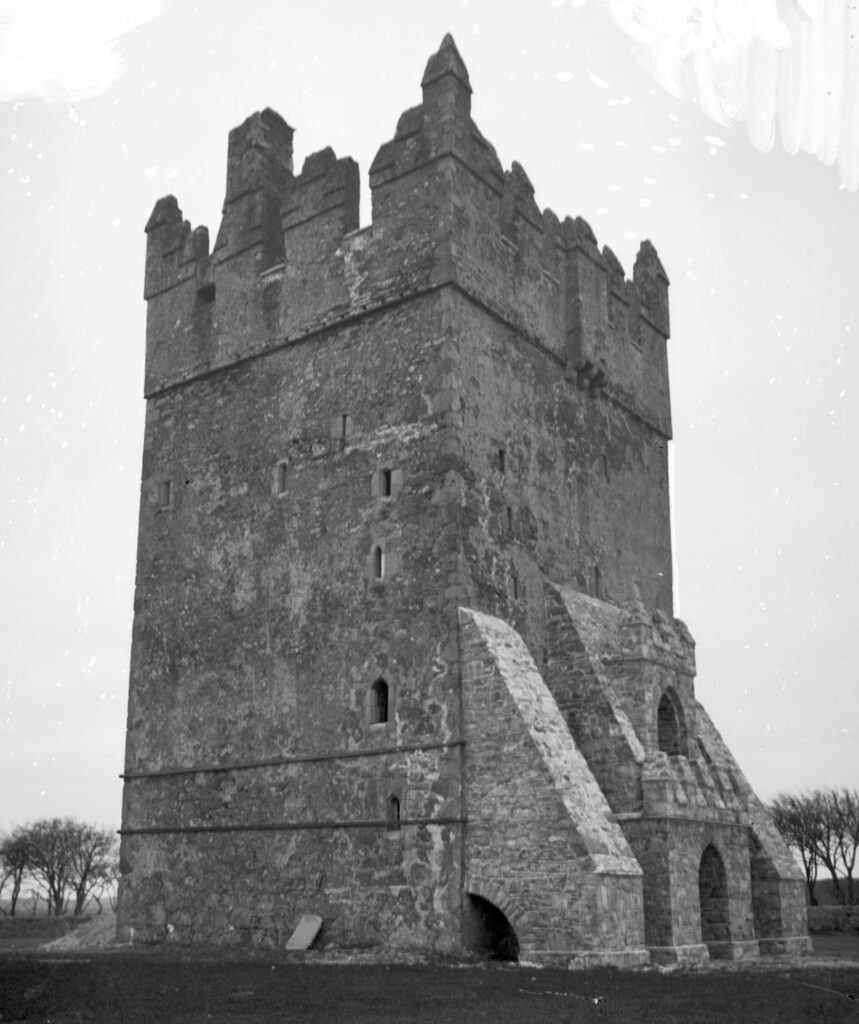
Dunluce Castle
Dunluce Castle clings to the side of a cliff on the Causeway Coastal Route of Northern Ireland. The castle kitchens collapsed from the rest of the building taking the entire kitchen and servants with it. Their screams are said to be heard on foggy stormy days. This is a really evocative site as it rises up when you go round the Causeway bend in the road.
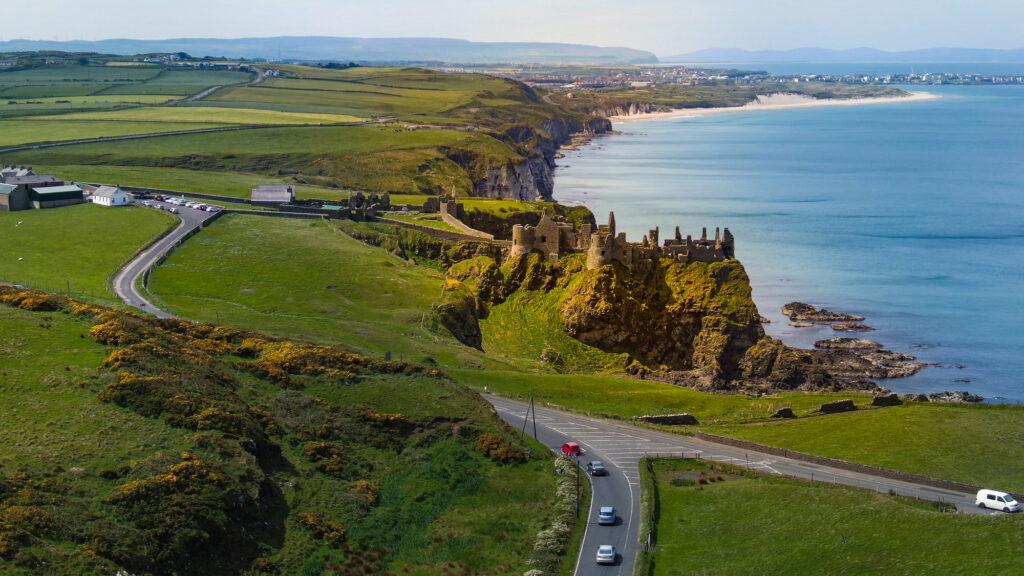
Dundrum Castle
Believed to have been built in or around 1177, Dundrum Castle was built by John De Courcy as part of his coastal defence after he invaded Ulster.
Dundrum Castle is located on a wooded hill northwest of Dundrum village near Newcastle. It controls access to Lecale and dominates Dundrum Bay. Its main purpose was to control the land routes from Drogheda to Downpatrick.

Castle hotels in Northern Ireland
Fancy staying in a castle in Northern Ireland for a night or two? Well, anything is possible and here are some of the loveliest castles to stay in when you visit Northern Ireland.
Belle Isle Castle
Originally called Ballymacmanus, Belle Isle Castle in County Fermanagh was once home to the old MacManus and Maguire families, and later the residence of generations of nobles. It has been inhabited since the 12th century. Now, extensively refurbished, you can stay in the castle, coach house and a variety of Belle Isle cottages.
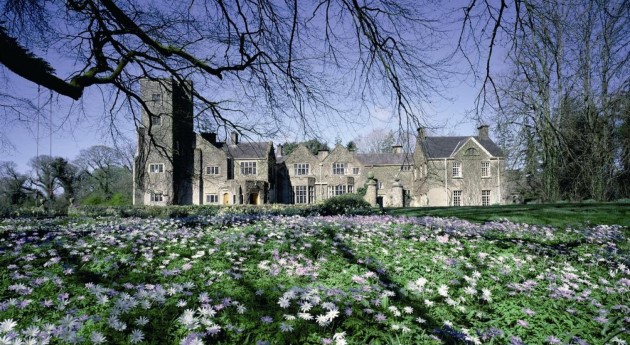
The stunning Belle Isle is nestled on the grounds of Belle Isle Estate. Rooms are tastefully decorated in a style that bears all the characteristics of a majestic stately home. The Estate has been designated a Special Area of Conservation and the award-winning castle is a stunning 17th-century country house offering lake views.
Crom Castle
Crom is a romantic nineteenth-century Victorian castle set in a 1900-acre estate and one of Northern Ireland’s most important conservation areas. The stunning castle estate, overlooking the waters of Lough Erne, is surrounded by acres of parkland and its West Wing is available for guests on a self-catering basis.
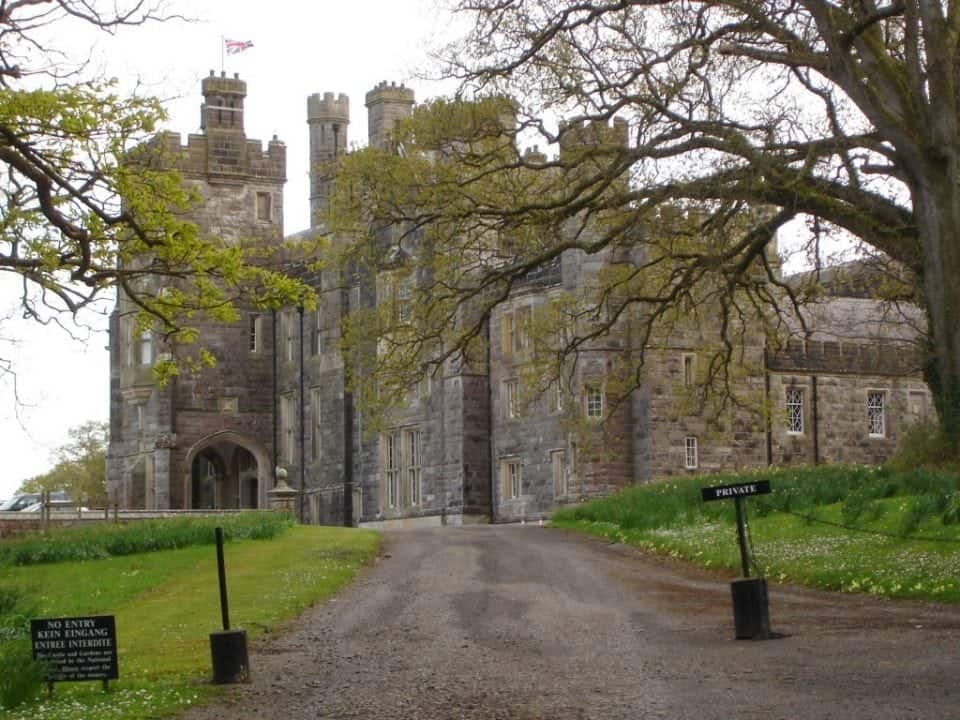
Narrow Water Castle
A privately-owned home, Narrow Water Castle is a luxurious self-catering property located in Warrenpoint, Co. Down. Dating back to the fifteenth century, the Elizabethan revival style castle was built next to the existing home, Mount Hall (1680) and completed in 1836. The self-catering apartment is in the original hub of the castle (Mount Hall).
Book a stay at Narrow Water Castle
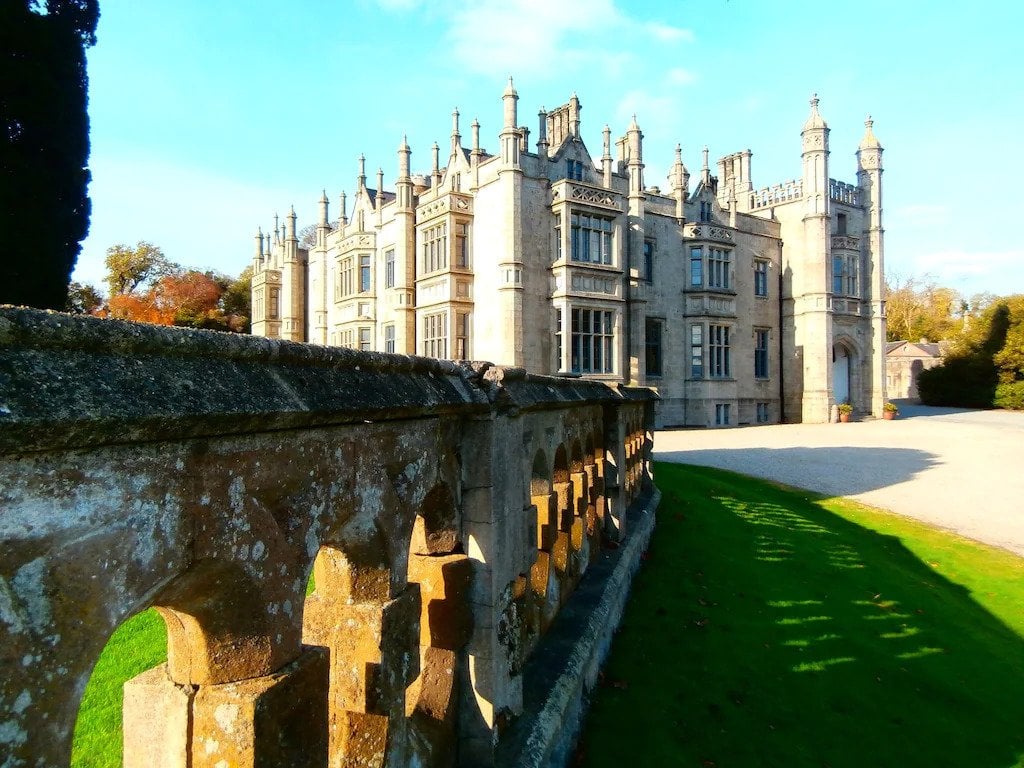
Ballygally Castle
Only 26 miles from Belfast and set on the spectacular Causeway Coast Ballygally Castle faces the sandy beaches of Ballygally Bay. The hotel has a host of amenities and a Door of Tours carved door from the Dark Hedges along with its resident ghost.
The Ghost of Ballygally has been around for the best part of 400 years. Locals believe that the ghost is that of Lady Isabella Shaw, wife of Lord James Shaw.
Book a stay at Ballygally Castle
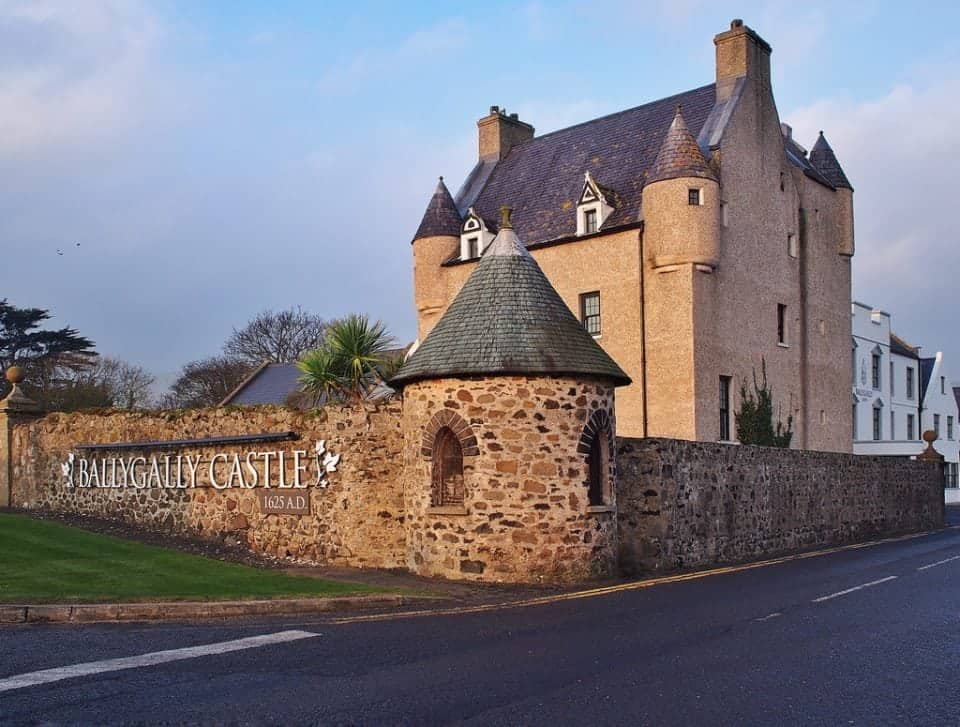
Helen’s Tower
Helen’s Tower is hidden on the edge of a winding lane on a beautiful hillside in County Down. It is a 3 storey, stone tower with accommodation for two guests for that perfect romantic getaway.
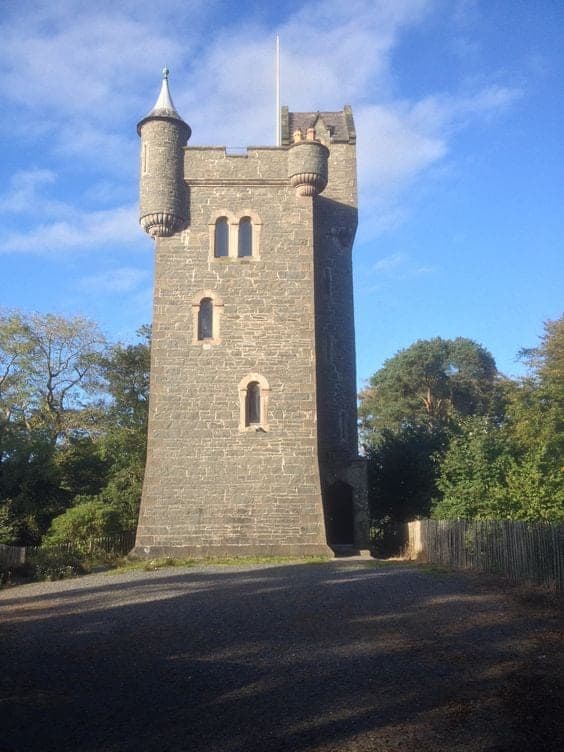
Killyleagh Castle
Built in the 12th century by Norman knight, John de Courcy, Killyleagh Castle is the oldest inhabited castle in Ireland today. It is located outside Belfast in the County Down area. It is a unique self-catering hotel where the two towers have been converted into self-contained apartments for short-term rentals. Guests can have the use of tennis courts and a swimming pool as well as the rooftop patio. The towers can sleep up to 15 people and offer modern facilities including central heating.
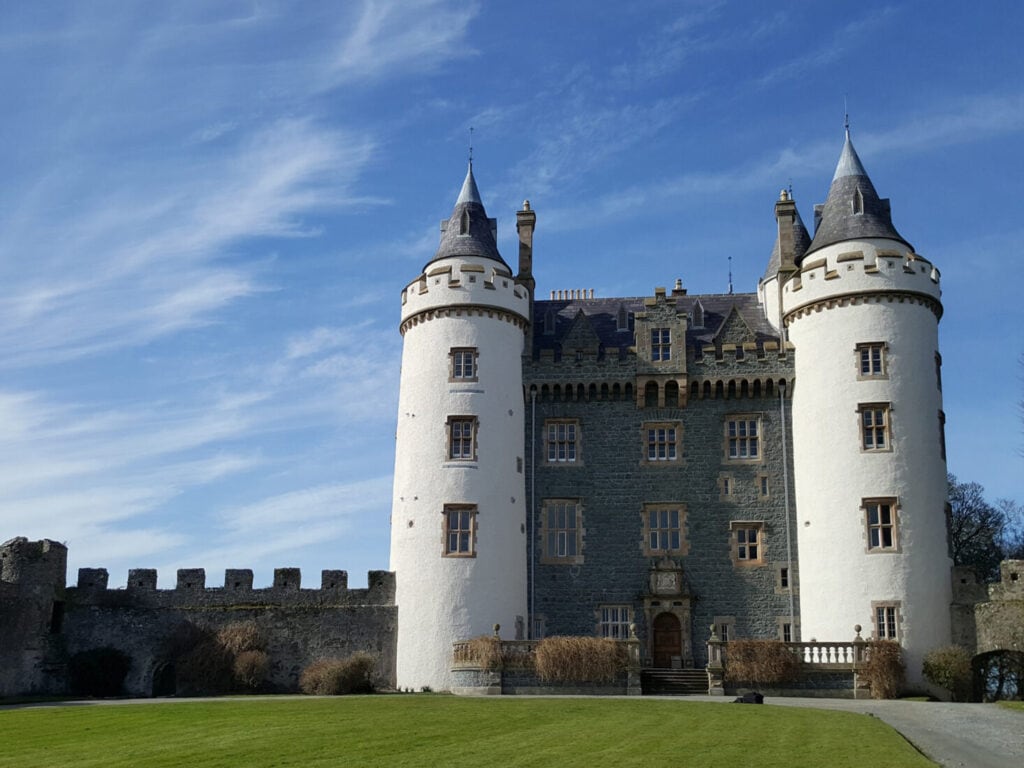
The Barbican Gatelodge
Along the Causeway Coastal route, this charming gate lodge sits on the end of a stone bridge over the Glenarm River. The Barbican Gatelodge comes complete with Gothic windows and a stone turret staircase. For a special view, head up to the roof garden in the early evening for some spectacular views of the coastline.
This self-catering accommodation is the perfect romantic hideaway and the ideal starting point for taking a road trip to discover the drama of the Causeway Coast. You can also visit the stunning gardens of Glenarm Castle and Estate.
Book a stay at the Barbican Gatelodge
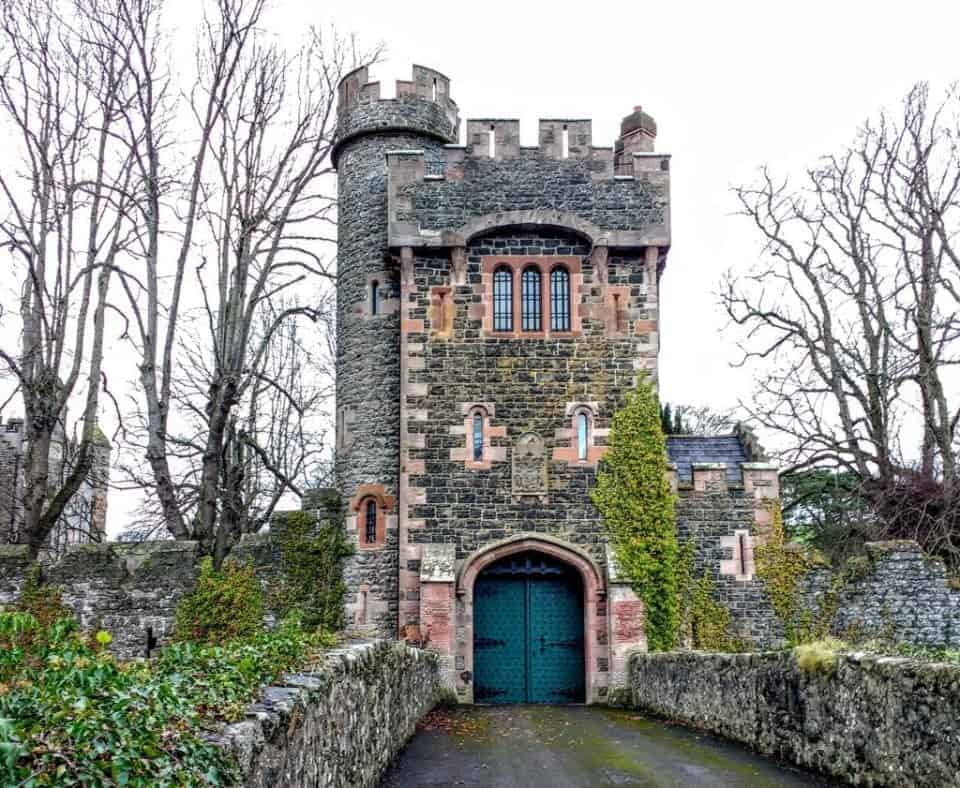
Folk Museums in Northern Ireland
Northern Ireland has a history that goes back thousands of years and archaeologists are constantly finding new wonders and updating information on our prehistoric and recent past. These two living Museums in Northern Ireland are fascinating places to wander and experience the past up close and personal.
Ulster American Folk Park
The Ulster American Folk Village is found on the outskirts of Omagh near the Donegal border. It contains the story of the emigrants who made the journey across the dangerous Atlantic to make a new home in America hundreds of years ago.
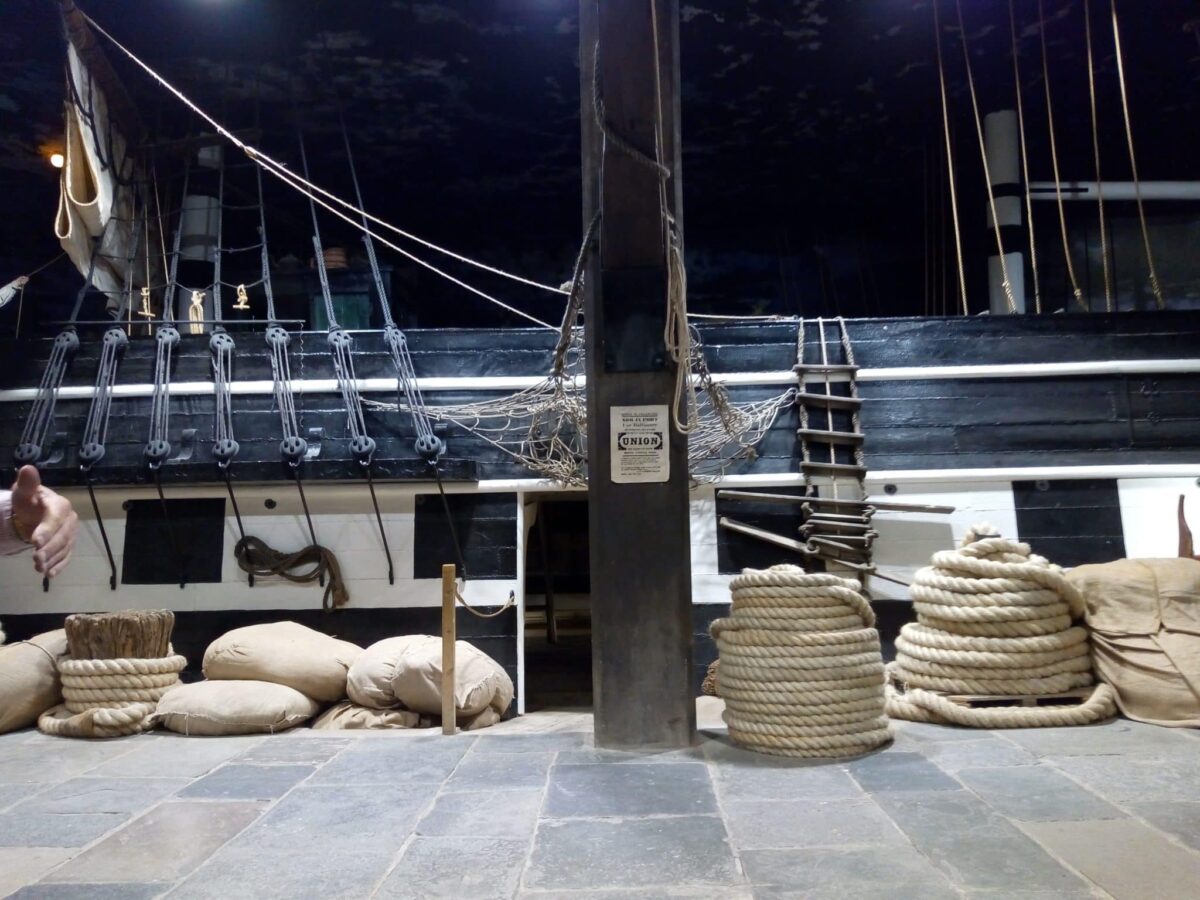
You can wander through the thatched cottages, log cabins and meet the characters who will demonstrate traditional crafts, tell a few Irish tales. Follow the path to the full-scale replica of the ships that brought the emigrants to America and then pass through the ship into the new world.
From post offices to shops, the village contains over 30 buildings and exhibits to explore and immerse yourself in the Irish experience.
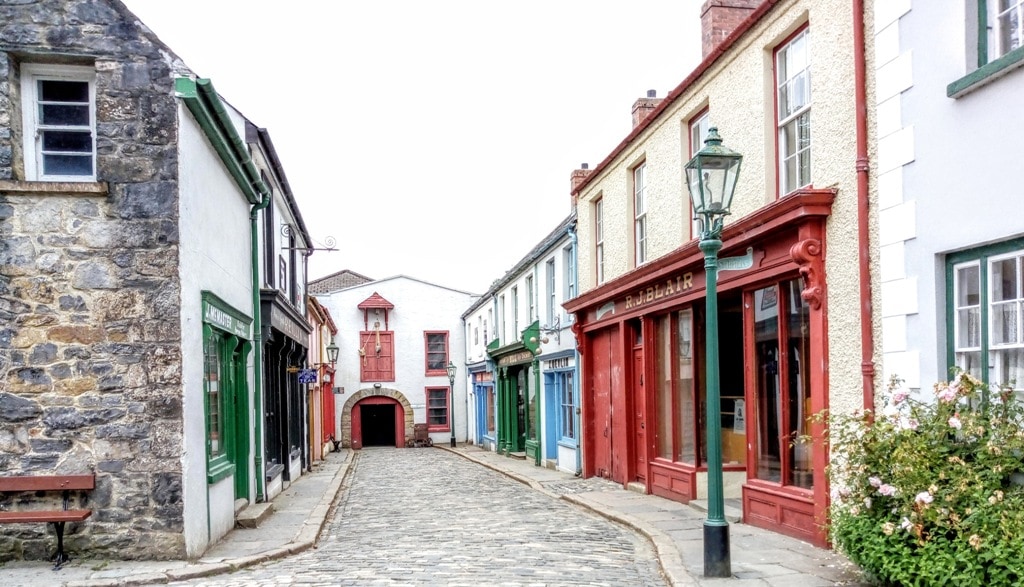
The Ulster Folk & Transport Museum
Another brilliant folk museum is located on the Eastern side of N. Ireland near Cultra around 25 minutes outside Belfast. The Ulster Folk and Transport Museum include both a folk museum where you can experience what life was like in N. Ireland over 100 years ago with costumed guides and hands-on displays.
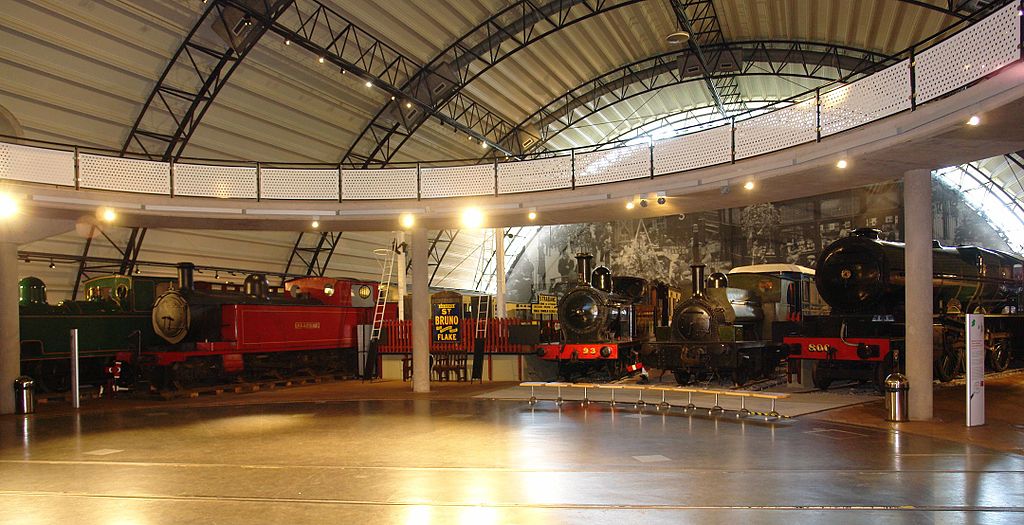
The Transport Museum has one of the most comprehensive transport collections in Europe. The collections include horse-drawn carriages, vintage cars, motorcycles, and some amazing steam trains.
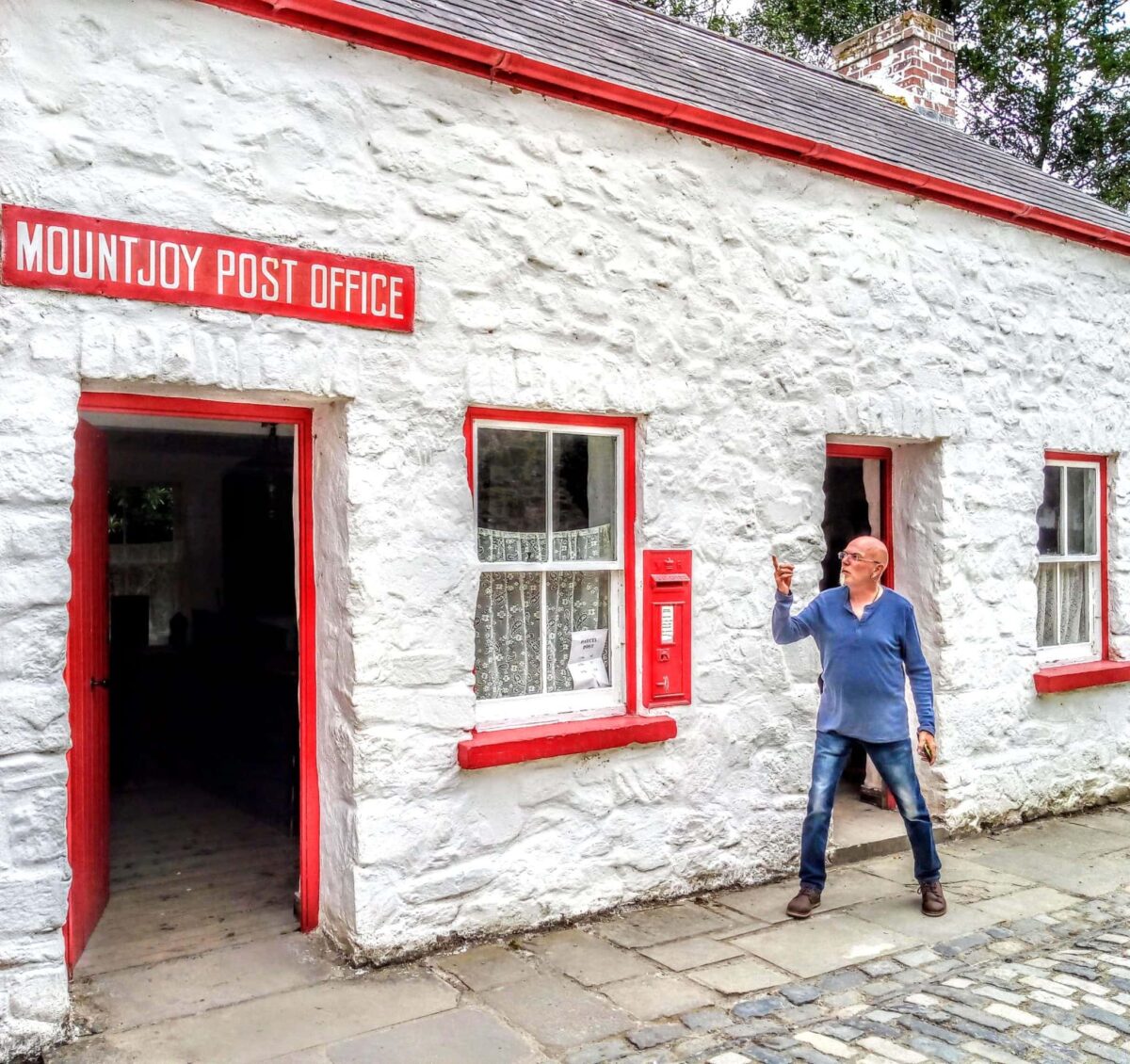
Neolithic Sites in Northern Ireland
Creggandevesky
Court tombs or ‘horned cairns’ are the most common Neolithic structures in the north of Ireland. The court tomb at Creggandevesky, near Carrickmore in Co Tyrone, is one of the most impressive. Probably in use around 3500 BC, the Creggandevesky court tomb was excavated from the bog in the 1980s. Cremated bones and grave goods were found in the interior chambers and 11 other court tombs have been discovered within a 10-mile radius of this site.
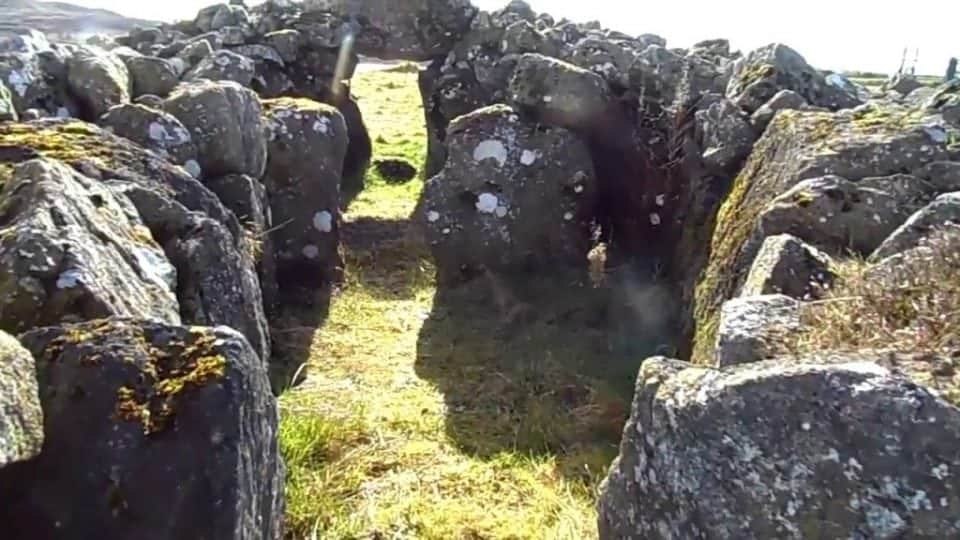
Legananny dolmen
There are more than 150 tombs or dolmens in Northern Ireland. The Legananny dolmen stands on the slopes of Slieve Croob in Co Down is another impressive site. Three upright stones support a large capstone, beneath which would probably have rested the skeletal remains of one or more people. Originally, a stone cairn would have covered the Neolithic tomb, but few traces of this remain.
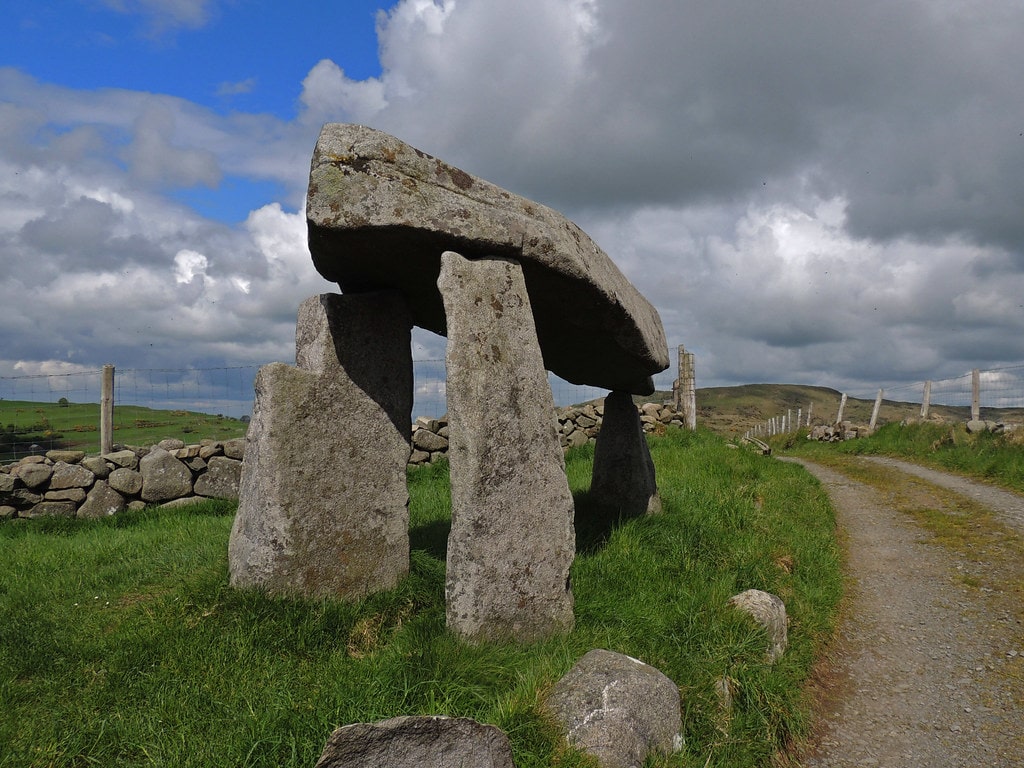
Ballylumford & Ballykeel Dolmens
Other portal tombs include the Ballylumford Dolmen in Islandmagee, Co Antrim and the Ballykeel dolmen in Co Armagh. Elsewhere in Co Down, there are dolmens at Annadorn, Goward and Kilfeaghan.
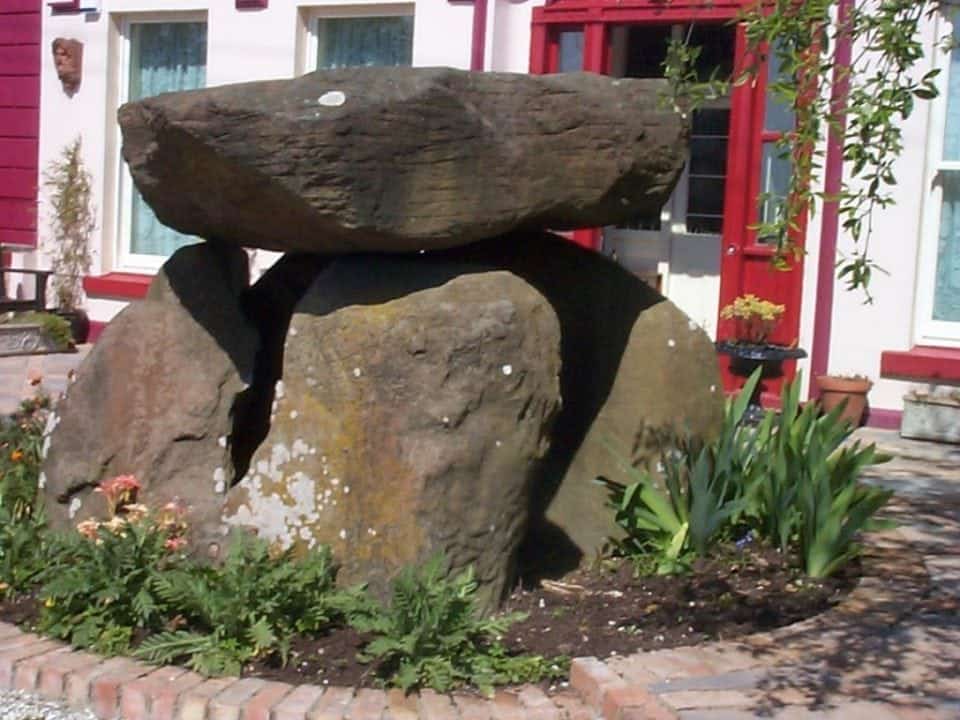
Giant’s Ring
On the southern outskirts of Belfast, the Giant’s Ring is a vast circular enclosure known as a ‘henge monument’. This structure encloses the remains of a passage tomb.
Probably dating from around 2000BC the site’s social or ritual function is unclear, but excavations and aerial photography show that the Giant’s Ring is part of a complex landscape of tombs, standing stones and other circular enclosures in the area.
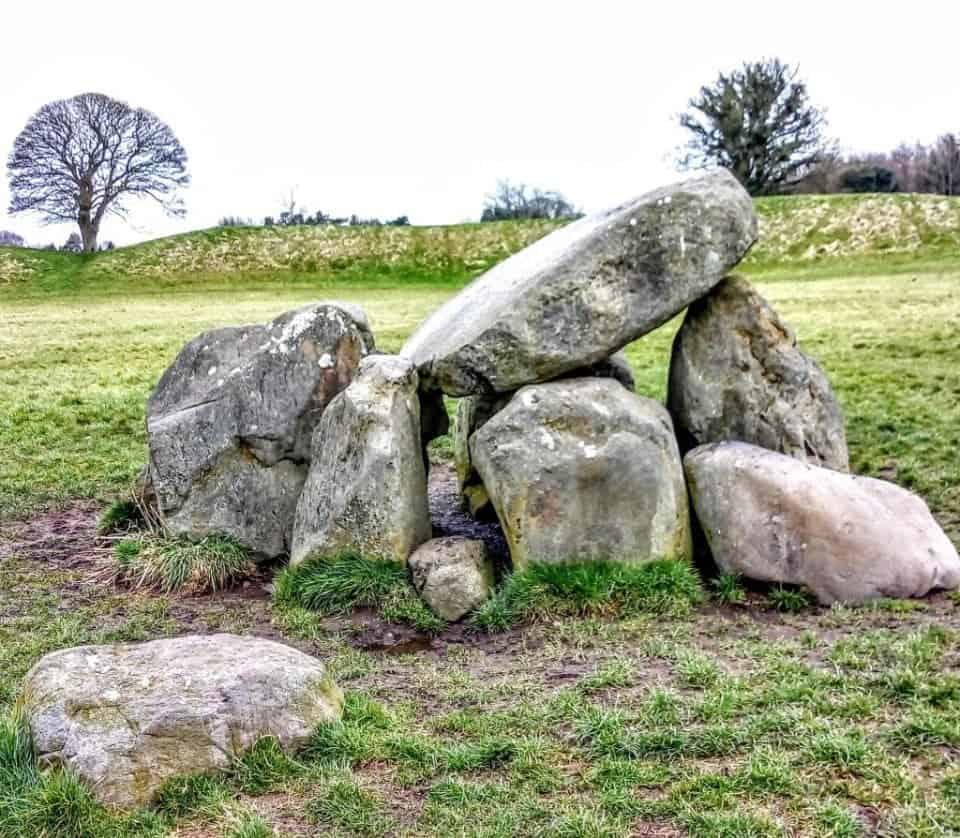
Beaghmore stone circles
Near Cookstown in Co Tyrone, the Beaghmore stone circles were excavated from a blanket bog in 1965. This site is a complicated arrangement of Cairns, rows of stones and stone circles. These remains seem to be orientated towards the midsummer sunrise.
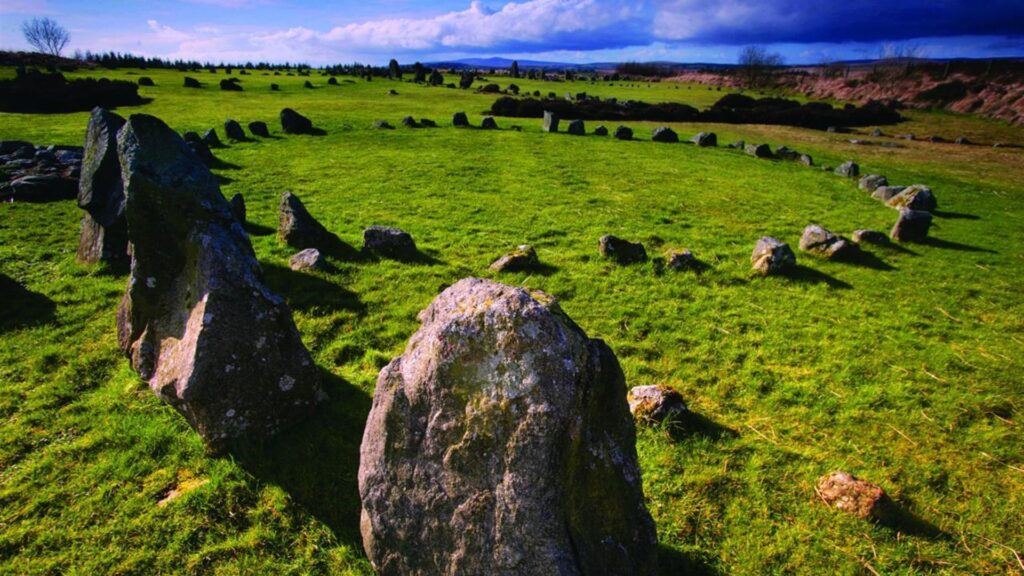
Navan Fort
The most important and impressive of Ireland’s ancient monuments, Navan Fort is identified with Eamhain Mhacha, the capital of ancient Ireland. A few miles west of the historic city of Armagh. It is believed that the ditch and bank surrounding the fort was built in the late Neolithic period whilst the larger mound within the henge has been used as a protective “fort” in later years.
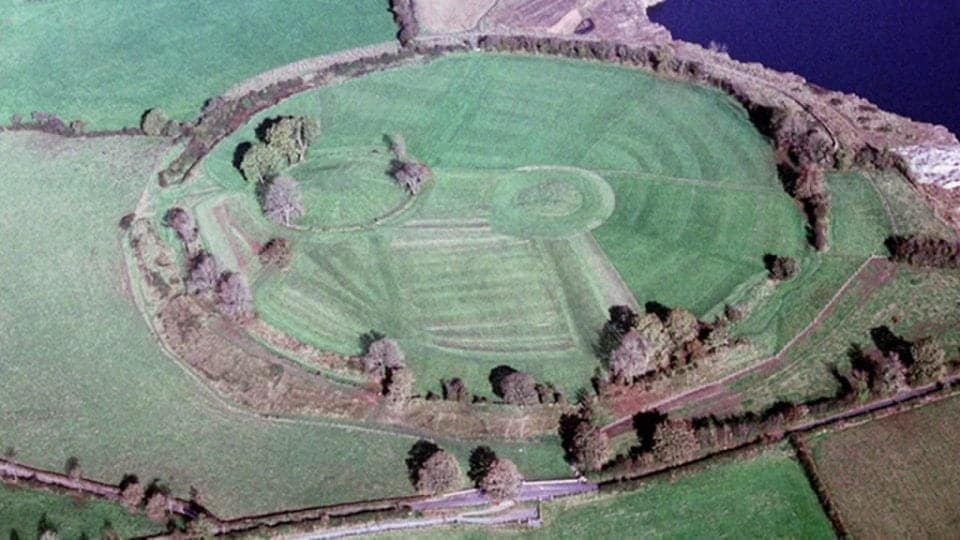
12 Ancient Ring forts in Ireland to visit
Places to see in Northern Ireland
Lisburn Linen Museum
The Lisburn Linen Museum’s goal is to collect and interpret artefacts from the Irish Linen industry. The exhibit from ‘Flax to Fabric: the Story of Irish Linen’. Trace the history of linen production in Ulster, from the earliest times to the present. You can see samples of the earliest linen production in N. Ireland and trace the history of this fascinating fabric.
There are free guided tours and demonstrations of the weaving of linen that are incredibly informative.
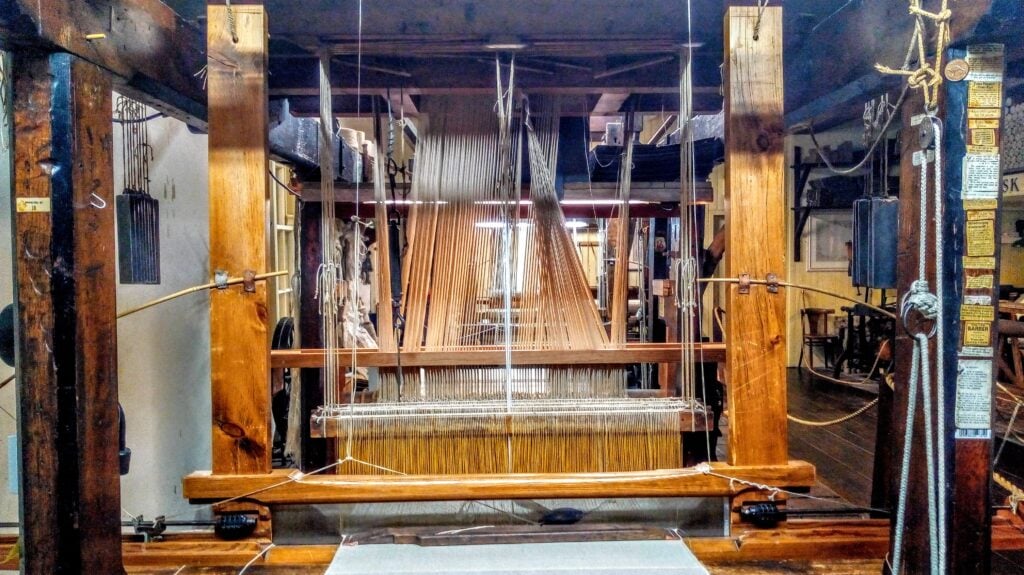
Game of Thrones Sites
Northern Ireland’s most famous for the Game of Thrones filming sites. There are over 31 filming sites for Game of Thrones in Northern Ireland and most can be visited either with an organized tour or it’s pretty easy to self-drive and see the particular sites you want to see.
Game of Thrones has changed Northern Ireland irrevocably for the good, bringing in hundreds of thousands of tourists a year you can get pretty bogged down at these sites in season.
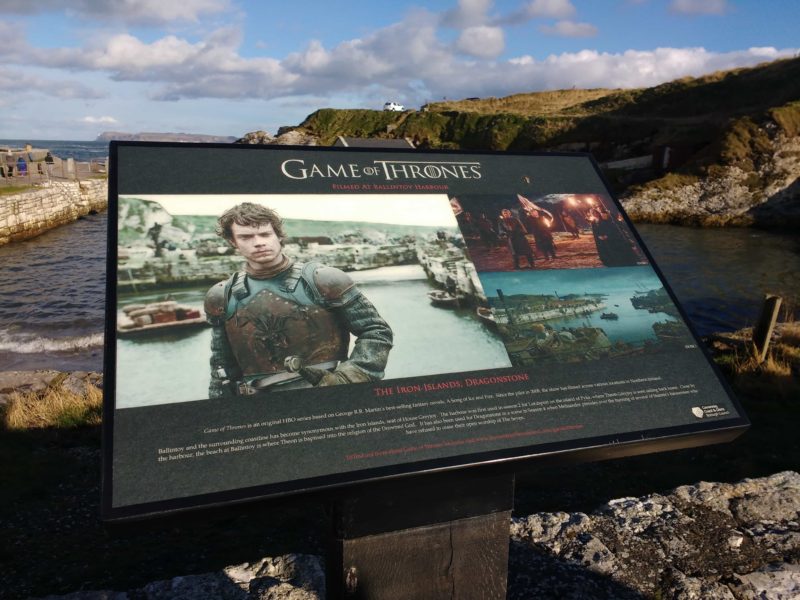
I would recommend if you want to do a GOT inspired Tour in N. Ireland try April to May and Sept to October once school is back in many of the tourist sites calm down a lot. These are a mere handful of the Game of Thrones tourist attractions in Northern Ireland
Dark Hedges
One of the most visited places in Northern Ireland is of course the Dark Hedges. Visiting The Dark Hedges or rather The Kings Road is a must. They are located in Ballymoney near Armoy. Tucked into the Bregagh road the ancient beech trees were planted by the Stuart’s in the 18th century. The hedges were used for the scene of Arya Stark’s escape from King’s Landing on the orders of King Joffrey.
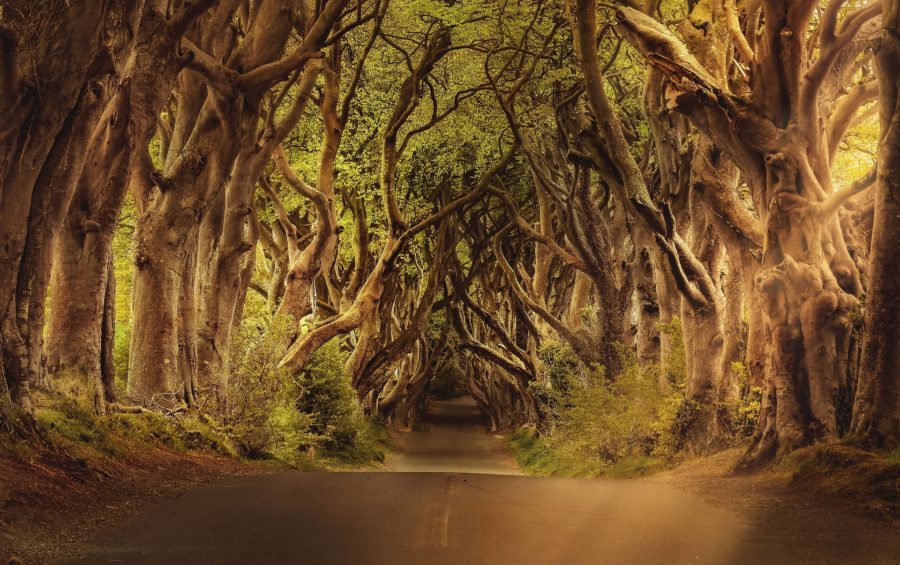
Tollymore Forest Park
Tollymore comprises over 600 hectares of forest from ancient redwoods, gothic stone arches and the remains of an 18th-century estate. If you can find your way to the Altavaddy Bridge this is where the dire wolves clearing can be found. Stroll along the river and you will see the deep hole where the Night’s Watchman Will comes upon the village where everyone has been killed by the White Walkers.
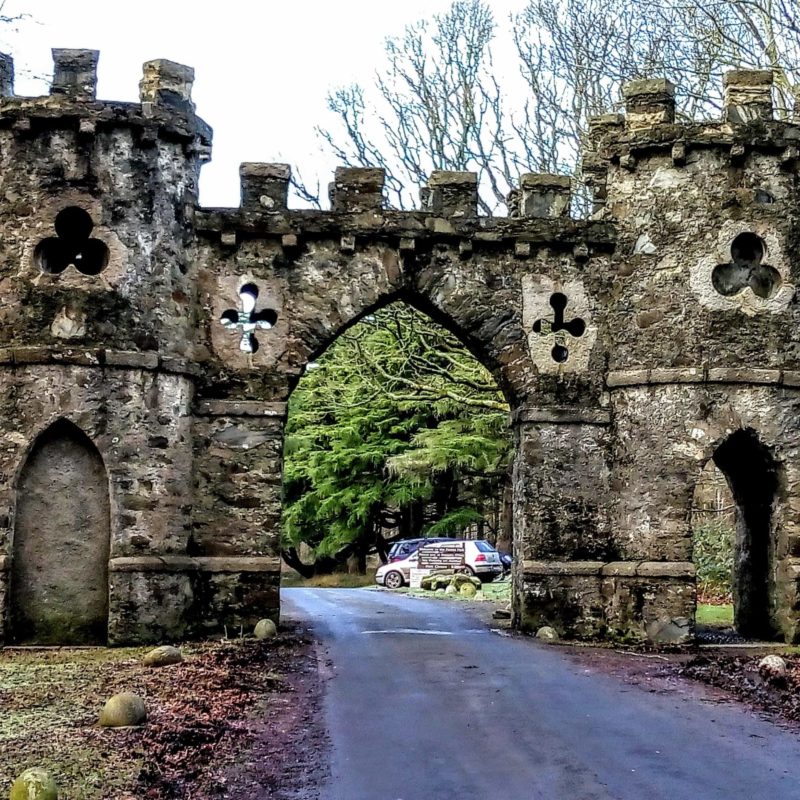
Inch Abbey
Inch Abbey is the remains of a Cistercian Abbey that were founded in 1180 by John de Courcy. There are lovely views towards the Cathedral town of Downpatrick and it is set beside the River Quoile. The Abbey was used as Robb Starks camp Riverrun.
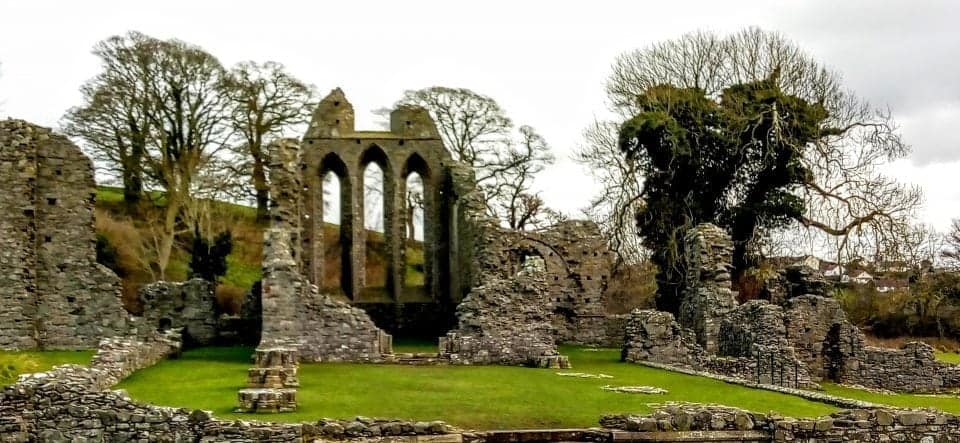
Castle Ward – Winterfell
The real-life Winterfell is at Castle Ward in County Down, Northern Ireland. Aside from hosting Game of Thrones tours, it’s a beautiful National Trust property on the shores of Strangford Lough, with an 18th-century stately home and acres of landscaped gardens to explore.
Castle Ward is a unique demesne of over 800 acres with a manor house that has two facades the first one, which faces the main road, is done in a classic Palladian style and the other side is completely gothic with pointed windows, finials and battlements.
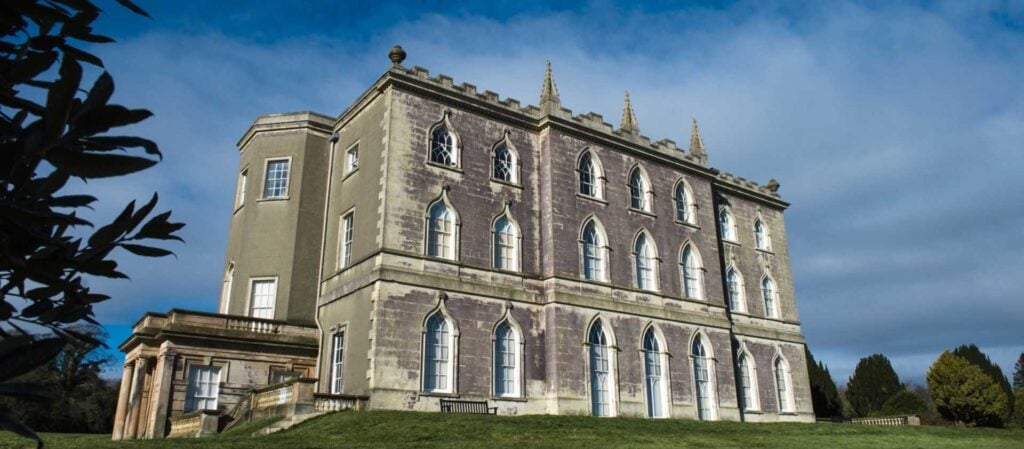
Cushendun Caves
The Game of Thrones scene where the shadow baby was born takes place here. This is where Davos Seaworth, on the orders of Lord Stannis, takes the sorceress Melisandre ashore to give birth to the murdering shadow.
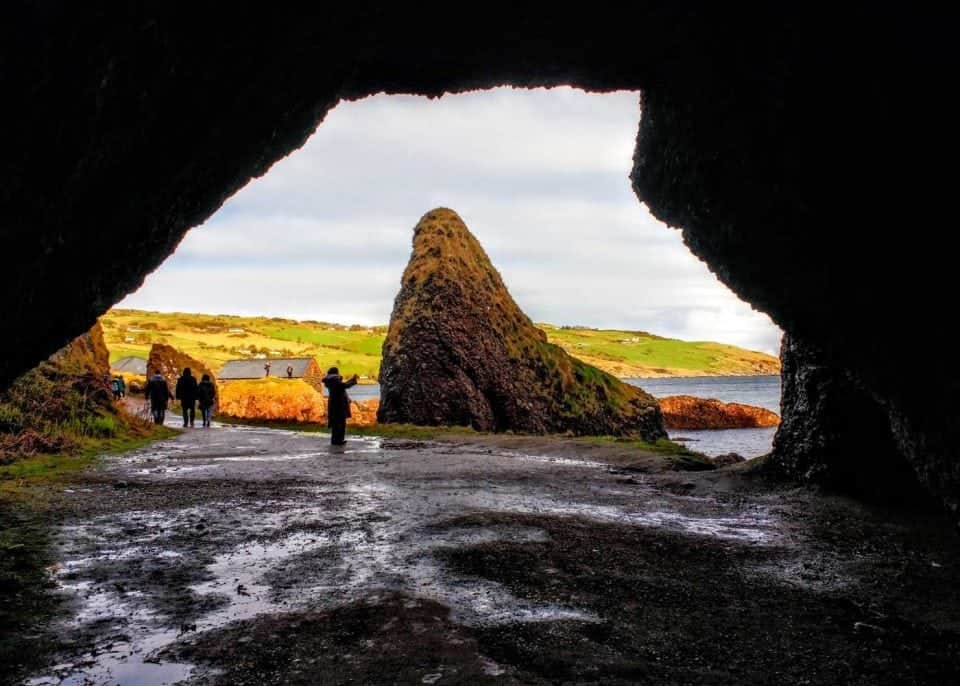
Ballintoy Harbour – the Iron Islands
Ballintoy is a village on the coast of Co Antrim with a small fishing harbour located at the end of a narrow, steep road down Knocksaughey hill. It features in season two of Game of Thrones when Theon Greyjoy returns home to Lordsport Harbour. It was also used as the location of Pyke, one of the eight major Iron Islands.
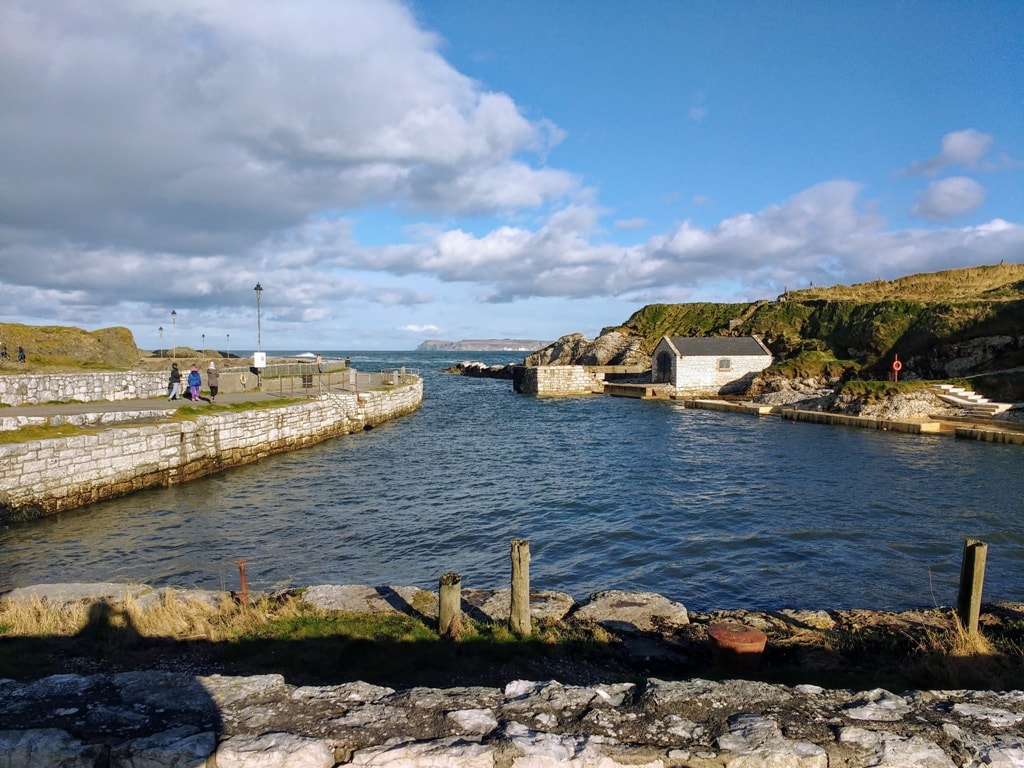
Glens of Antrim
For me personally one of the best things to do in Antrim Ireland is to visit the Glens of Antrim these are some of the most beautiful places in the world and the drives will mesmerize you from start to finish. There are 9 Glens of Antrim, each and every one with its own story and its own type of beauty.
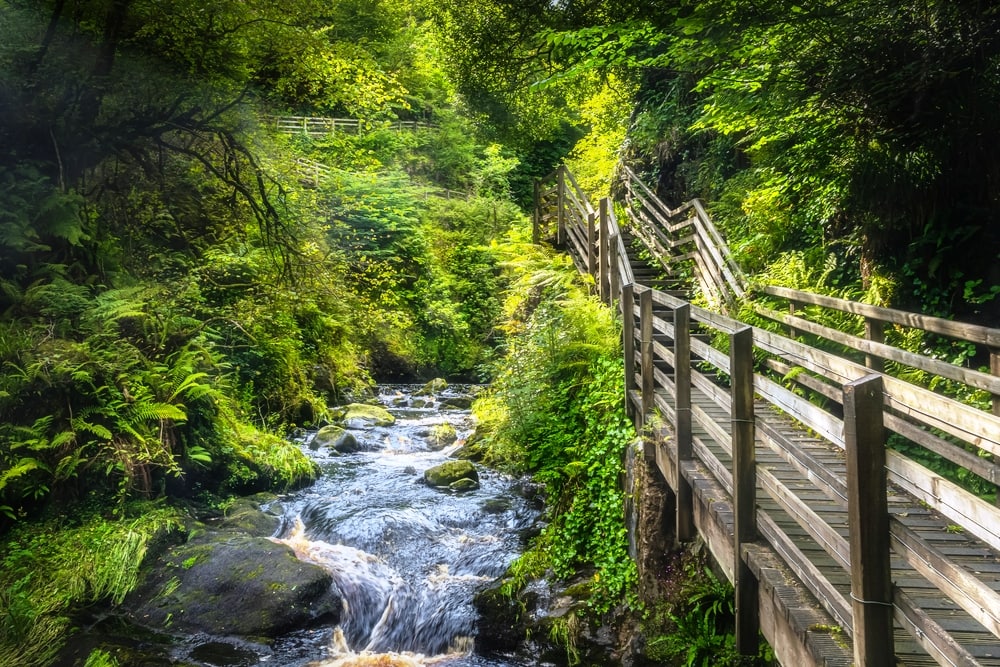
Each of the Nine Glens has its own ancient story but the Queen of the Glens is Glenariff Forest Park with its ladder farms, grazing sheep and rushing waterfalls.
Glenariff Forest Park
Glenariff, the Queen of the Glens, is one of the nine Antrim Glens in Northern Ireland. Glenariff Forest Park covers over 1,000 hectares with planted woodland, lakes, a stunning waterfall, outdoor recreation spaces and conservation areas.
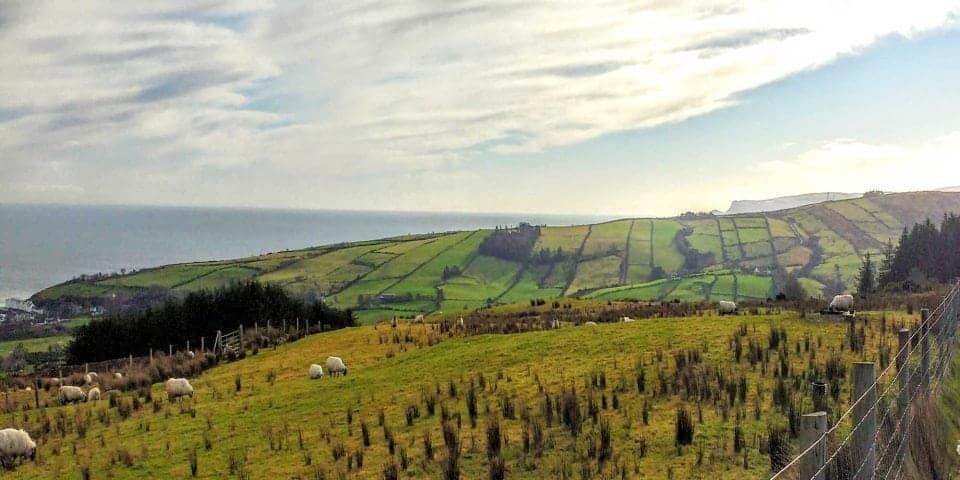
Due to the richness and diversity of these plants, part of the Glenariff Glen has been designated as a National Nature Reserve. The wooden boardwalk that winds through the glen and alongside the river gorge was first built about 100 years ago and has been carefully reconstructed to provide a spectacular walk.
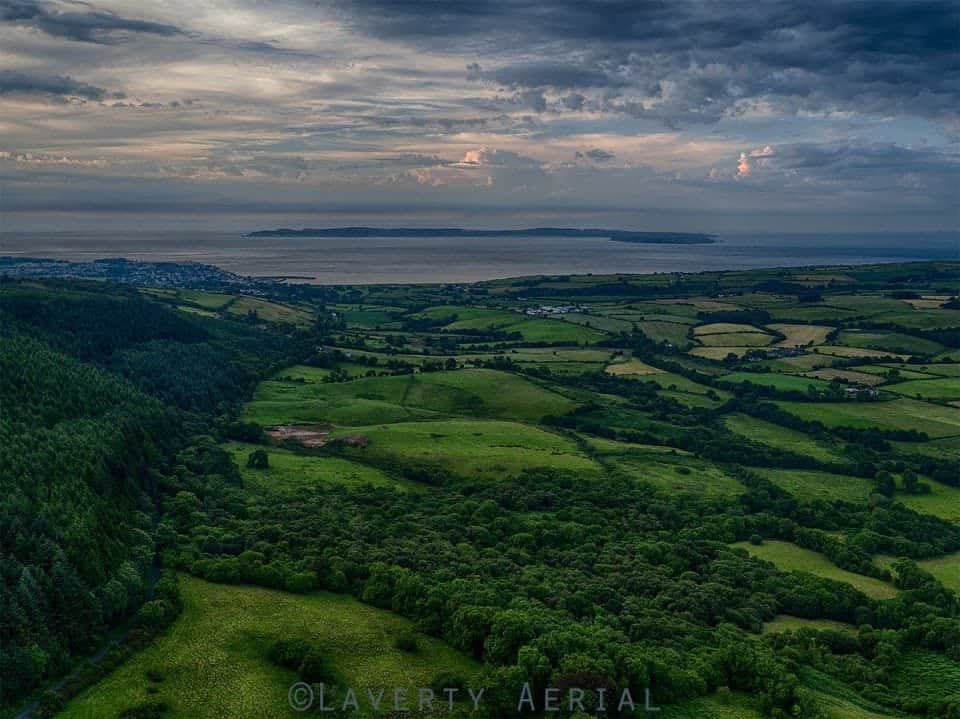
Mourne Mountains
The Mourne Mountains are the highest and most dramatic mountain range in Northern Ireland. Crossed and re-crossed by a phenomenal network of paths and tracks and voted the Best Walking Destination in Northern Ireland by WalkNI. The Mournes are divided into 2 very distinctive areas – the Eastern or ‘High’ Mournes and the Western or ‘Low’ Mournes, each with its own distinctive hike or walking routes.
The Mourne Wall
The Wall which is now a famous landmark running through the mountains was finished in 1922 after 18 years of work. The stonewall which stands up to feet high and 3 feet wide was originally built to keep cattle and sheep out of the water in the Silent Valley reservoir.
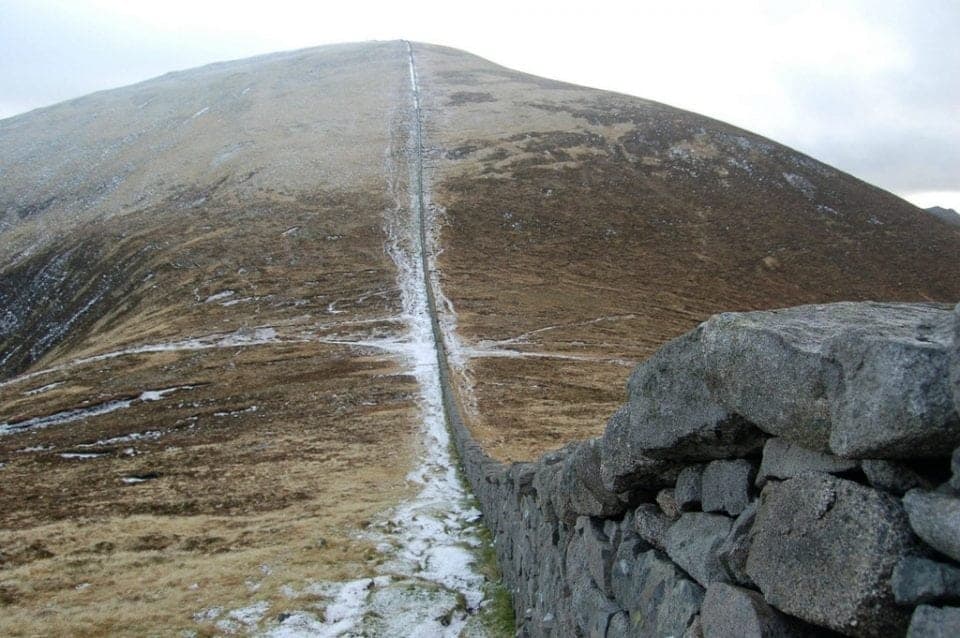
During the 18th and 19th Centuries illegal cargo ships, stocked full of tobacco, wine, spirits, leather, silk and spices docked at the foot of the Mournes in Newcastle. Smugglers then loaded up donkeys and ponies and trekked through the Mourne Mountains to Hilltown. Trade was so popular and the route so widely used that the hooves of the heavily laden ponies soon created a track. The track stills exist and today is known as the “Brandy Pad” route.
Slieve Gullion
The Slieve Gullion Scenic Drive runs through 10 acres of woodland and mountain heath, which turns the mountains a luminous purple in the summer months. There is a marked trail, which leads from the scenic drive up to the ancient passage tombs on the south summit of Slieve Gullion and a Bronze Age tomb on the north side of the Mountain. Plenty of places to rest grab a great coffee or tea and just enjoy the beauty of these mountains.
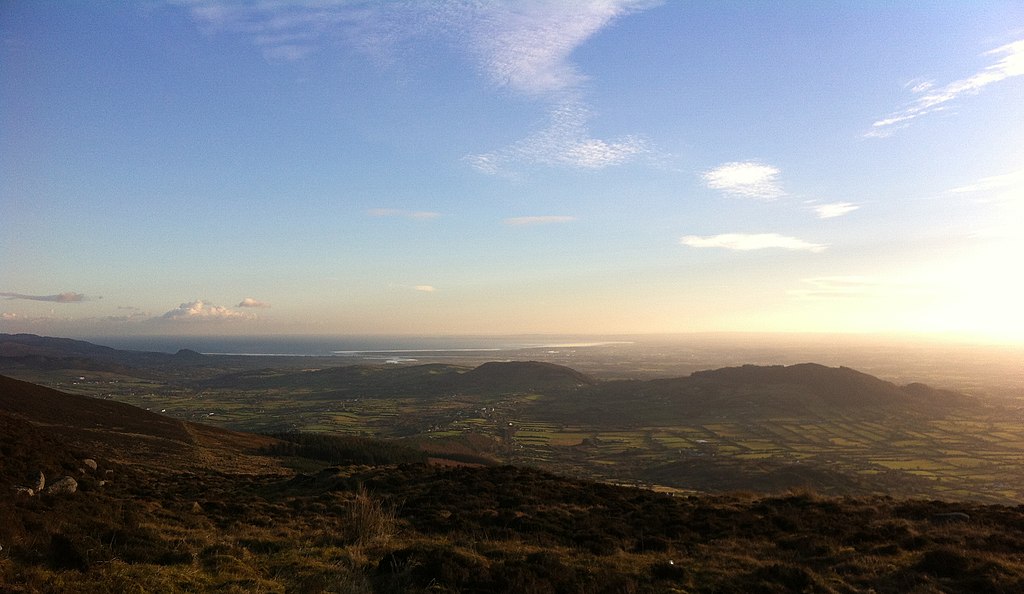
Slieve Gullion Forest park
Slieve Gullion Forest Park offers the opportunity to experience tranquil woodland trails, stunning views across the Ring of Gullion, Mourne Mountains, Cooley Peninsula and Armagh Drumlins and top-class facilities for walkers and families.
Play in the Adventure Play Park; explore the Giant’s Lair in the wonderful Hawthorn Hill Forest Nature Reserve and woodland trails, or take a turn in the ornamental walled garden, where you will find picnic benches, an outdoor performance stage, an alfresco coffee bar (open in the summer) and a wildlife pond with covered seating areas.
The Gobbins
The Gobbins experience is not for the faint-hearted or unfit and if you are mobility challenged you won’t be able to do this walk. Proper gear is required and safety helmets are required and supplied. You must be wearing good solid hiking boots and rugged outdoor clothing it can get very cold with the winds and the waves out there.
If you can’t climb 50 stairs, you can’t do the Gobbins. It’s a narrow path hugging the cliff face that takes you around the Gobbins. Staring into the North Channel, taking in hidden tunnels and caves that were once home to smugglers and pirates the Gobbins is immensely challenging.
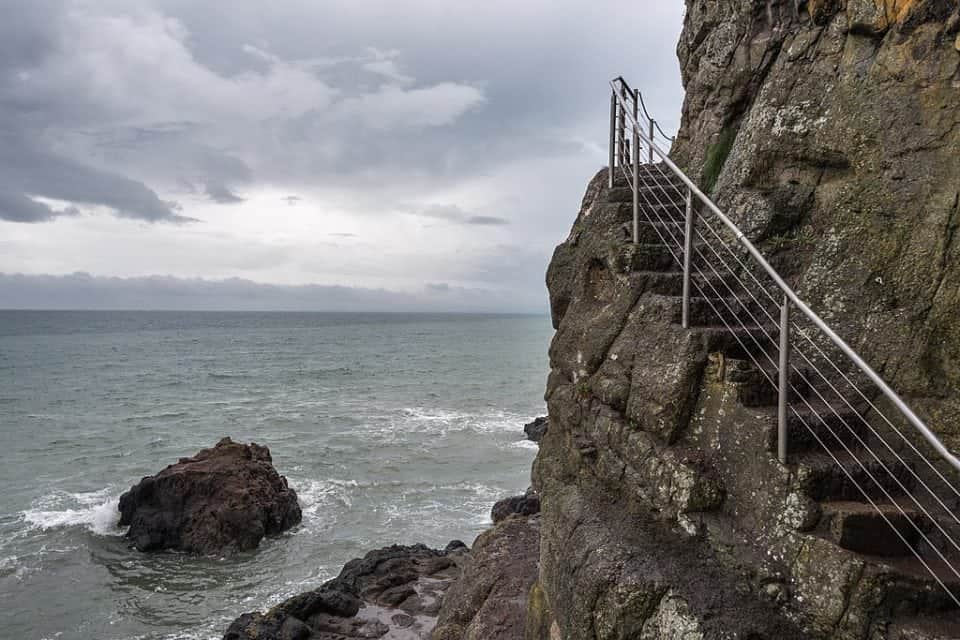
Strangford Lough
Take a beautiful ferry ride across Strangford Lough to the Republic of Ireland. You can stop at the Cuan on the Northern Irish side to enjoy a fine meal and view some GOT costumes and props.
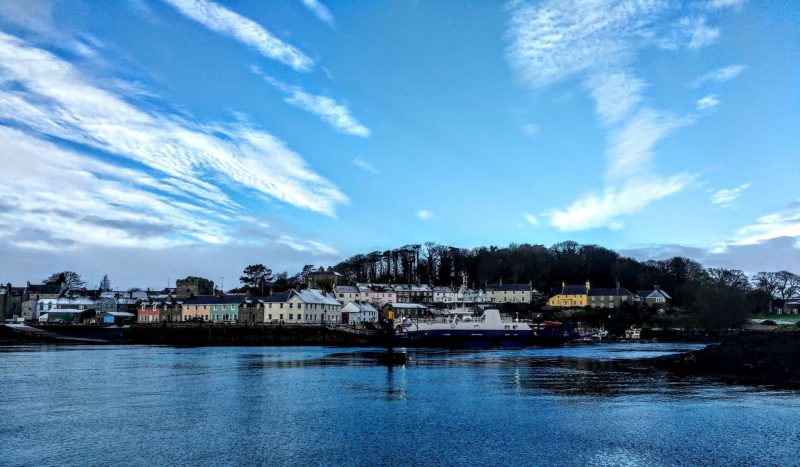
Sperrin Mountains
The Sperrins are a designated Area of Outstanding Natural Beauty and one of the country’s largest upland areas. The Sperrin Mountains are Northern Ireland’s most extensive mountain range and can be found along the border of counties Tyrone and Derry The Sperrins span over 40 miles, and they are described in National Geographic’s. List of the world’s 101 scenic drives. The Sperrins are wild, untouched and raw and there are four scenic driving routes through, around and over the Mountains to be enjoyed.
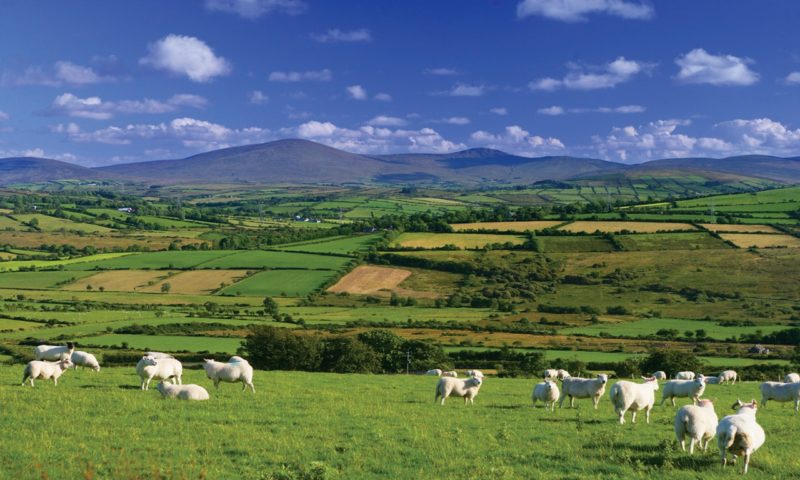
The Barnes Gap
The Gap is situated on the Central Sperrins Driving Route; the glaciers driving through the mountains caused this deep groove in the ridge of hills lying to the south of Glenelly Valley. You can follow in the footsteps of St Patrick at the Barnes Gap.
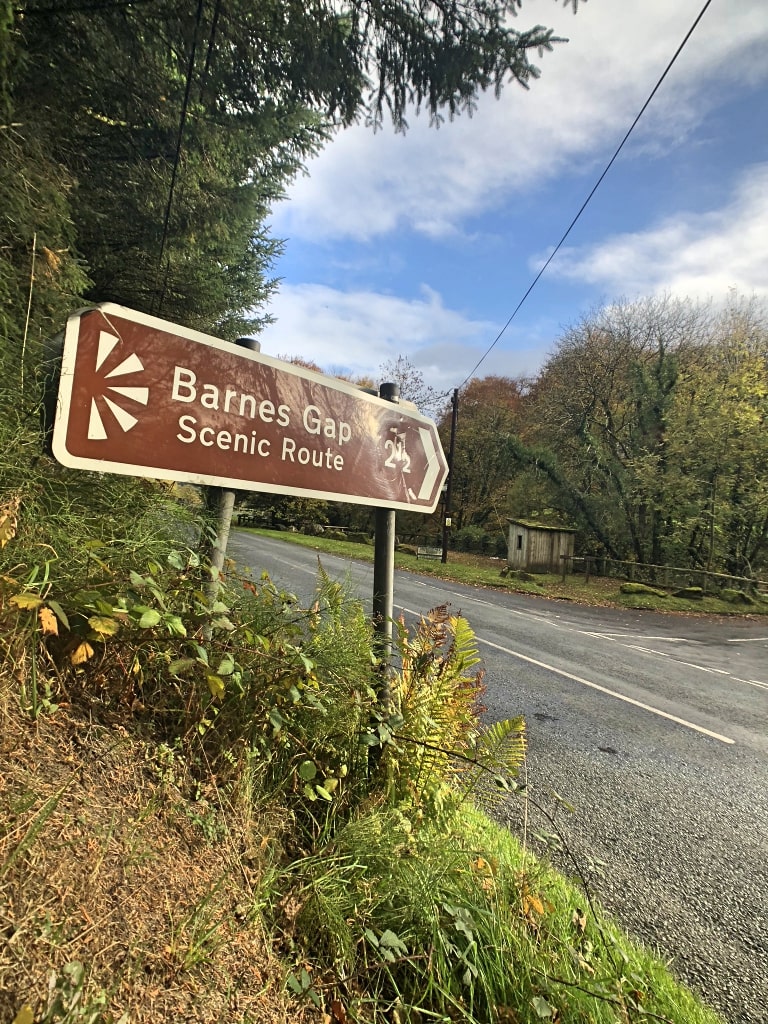
Pigeon Top
Is located on the South Sperrins Route to the west of Omagh, this popular viewpoint and picnic area offer some fantastic views of surrounding hills such as Bessy Bell, and further afield.
Slieve Gallion
Is just off the East Sperrins Route near Moneymore, this mountain lies at the eastern edge of the Sperrins with a road leading much of the way to the top. Take in the stunning views over Lough Neagh, the Sperrins, Antrim Hills and the Mourne Mountains.
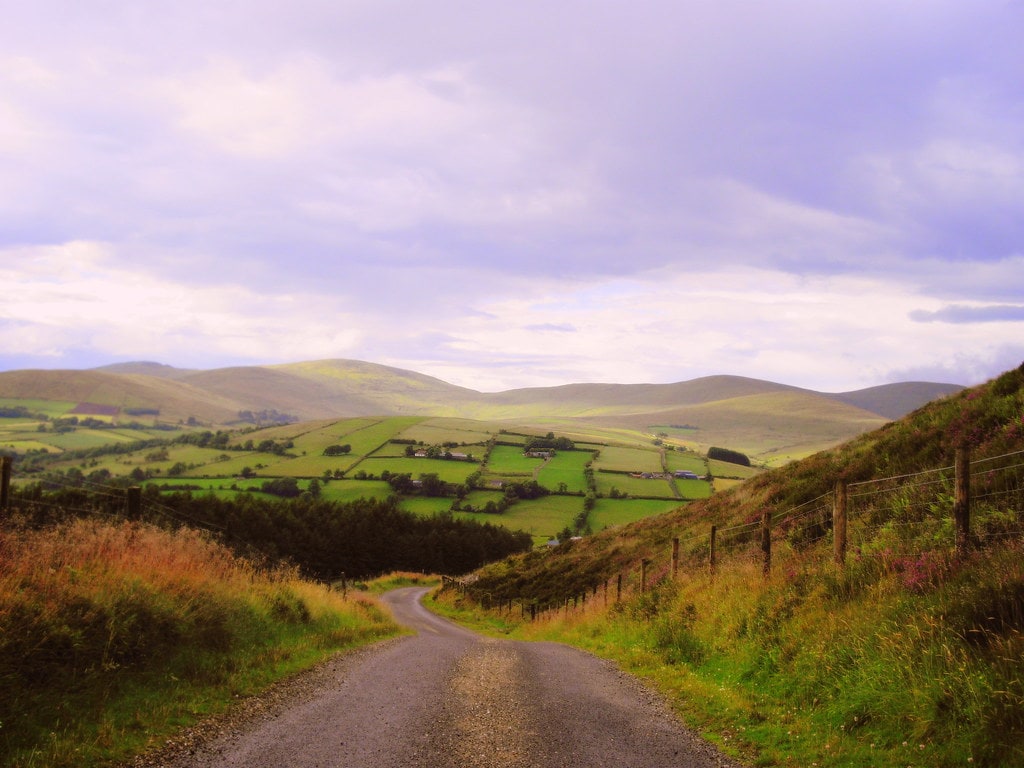
Lough Erne
Dominated by the twin lakes of Upper and Lower Lough Erne, Fermanagh has some of the most scenic forest drives including the Lough Navar Forest across the lower expanse of Lough Erne.
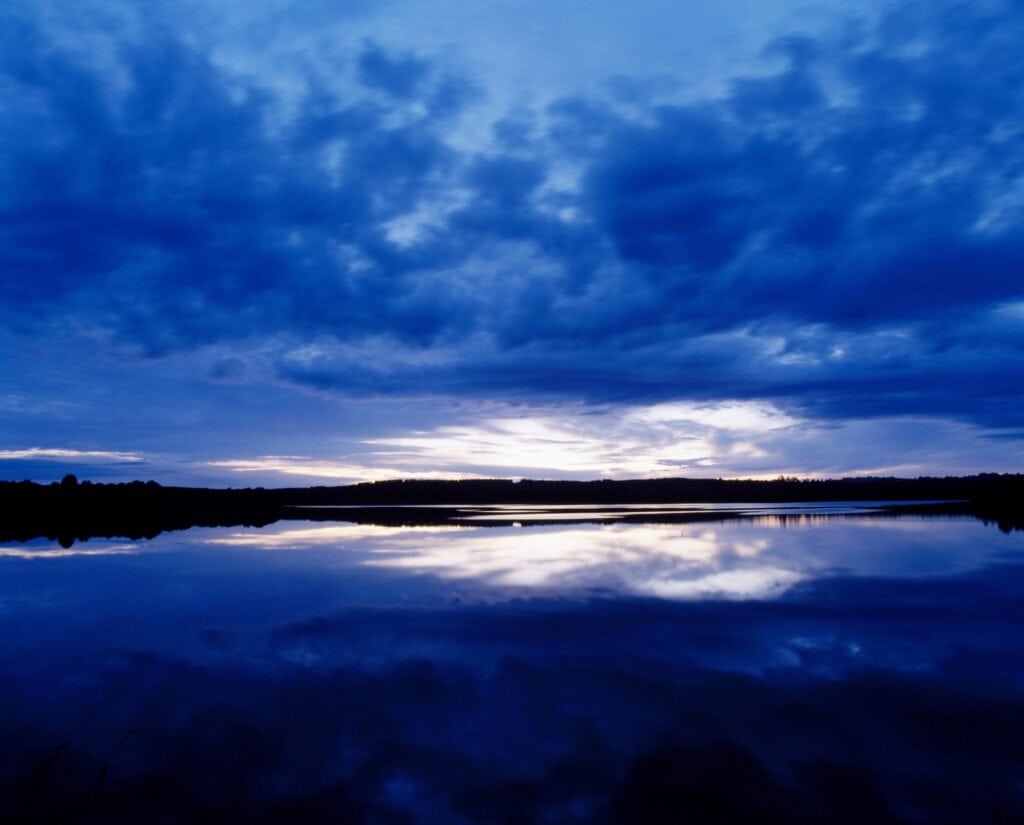
Marble Arch Caves Geopark
The Marble Arch Caves Global Geopark, situated just outside Enniskillen, County Fermanagh is one of Europe’s finest show caves. The Marble Arch Caves are not exactly a UNESCO World Heritage Site, but they were named a UNESCO Global Geopark due to the world importance of their geology and landscapes. If you are a Game of Thrones Fan you will recognise the cave which was which was home to the rebels that captured Arya.
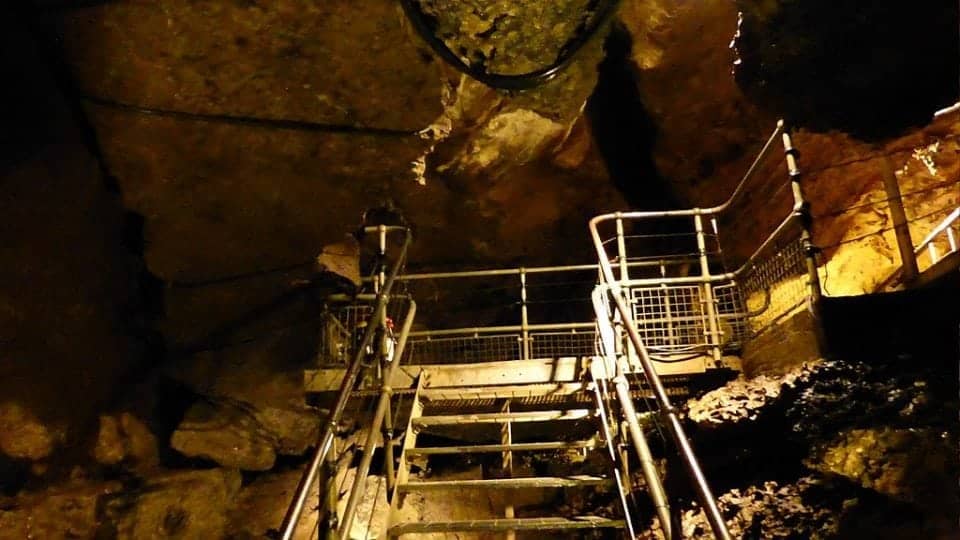
Carnmore Viewpoint & Slieve Beagh Hills
Check out Carnmore Viewpoint, which is, located in the Slieve Beagh hills with outstanding views of the countryside’s drumlins and small loughs and you can rest in the stone chair.
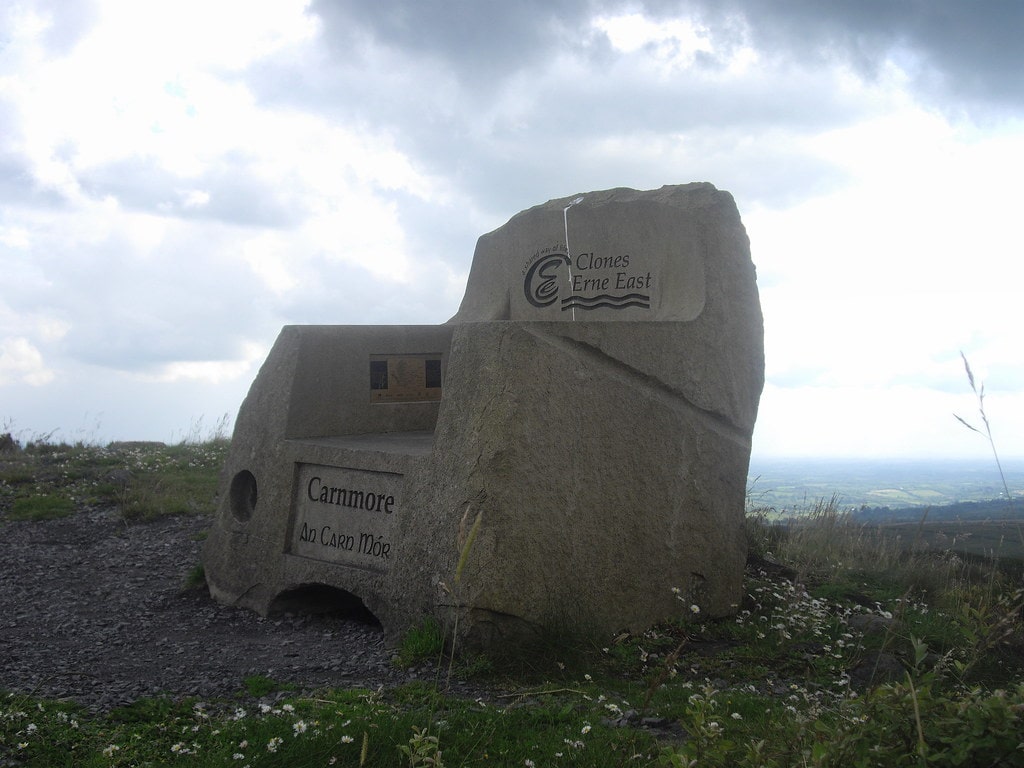
Maghery Country Park
While in Fermanagh check out the Maghery Country Park, which you will find, tucked away in the S.W. corner of the lough, Located in the village of Maghery, on the shores of Lough Neagh. The park covers thirty acres, includes five kilometres of woodland walks and picnic areas, and is used for bird watching, fishing, and walking.
Lough Neagh
The park is located on both the River Blackwater and Lough Neagh Canoe Trails with jetties on site. You can visit and take in some beautiful northern Irish countryside, then you might want to spend the day exploring the area of lough Neagh. Touching five of Northern Ireland’s six counties, Lough Neagh is the largest freshwater lake in the British Isles and boasts a variety of attractions and some great, unspoilt scenery.
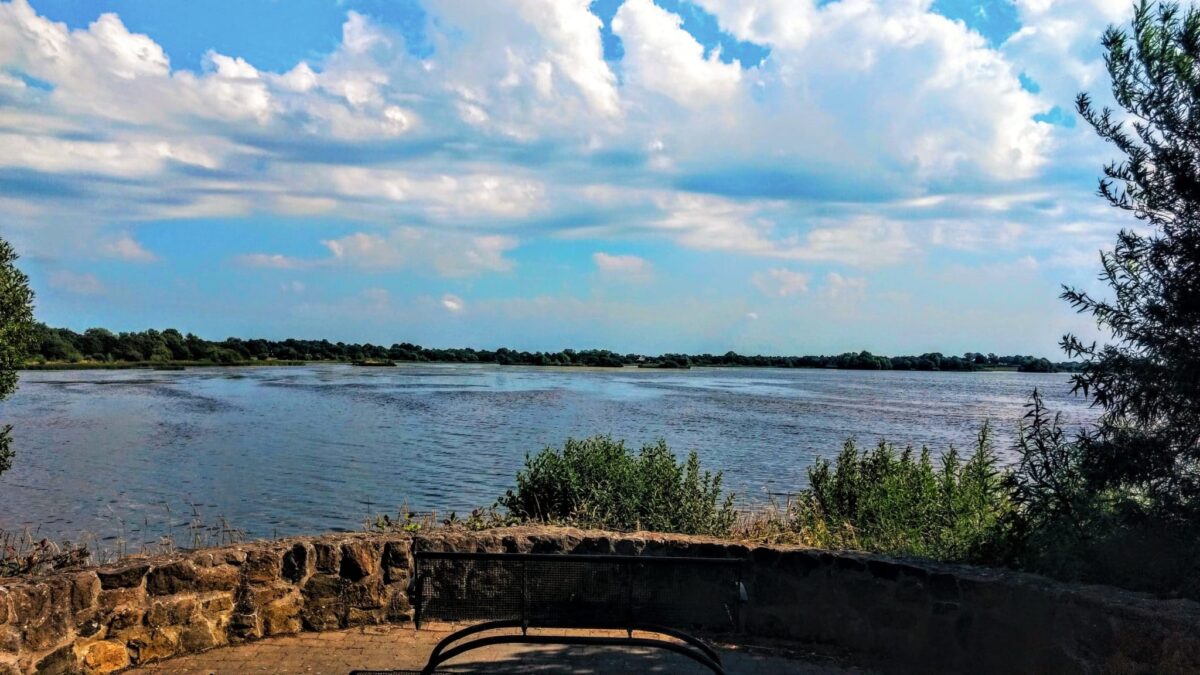
Cranfield Church
The park has some great views of the shoreline and out to Coney Island. Visit Cranfield Church and Holy Well, which is located in a secluded location on the northern shore of Lough Neagh, the medieval church, occupies a picturesque setting overlooking the shore.
Stairway to Heaven
Another absolute must-see in Fermanagh is the Stairway to Heaven one of the best walking spots in N. Ireland. The boardwalk raises up to the sky when standing at the beginning of it and so it got its name.
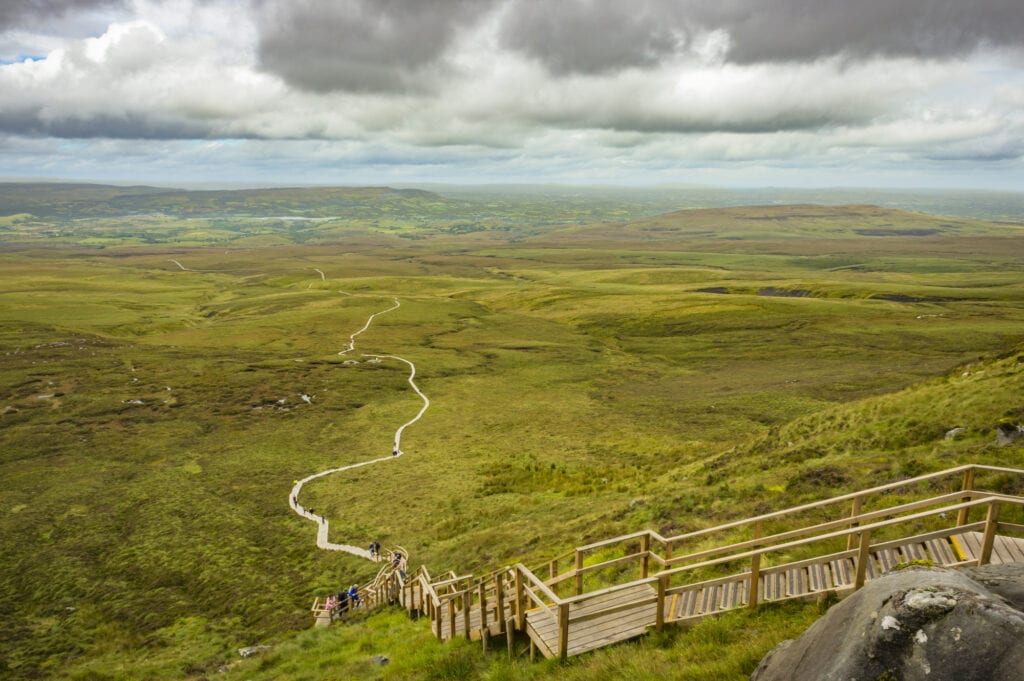
Boa Island
Boa Island is located in Lower Lough Erne which is in Fermanagh. Lough Erne is located in the north-west corner of Ireland. The Lough is made up of 2 large lakes with Enniskillen sitting on an island that separates the upper and a lower lough that runs into the sea in Donegal through Ballyshannon.
Within the lake are several beautiful and mysterious islands including Boa Island, Lusty Beg, Lusty More, Devenish and White Island.
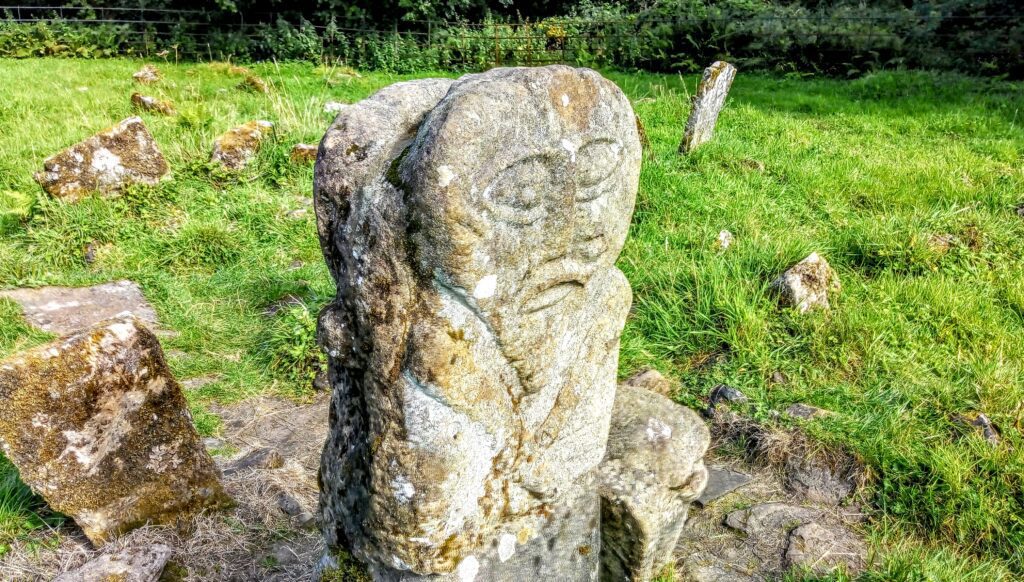
The Janus Stone on Boa Island predates Christianity and it is believed that it goes far back in time to pagan Ireland. The stone itself is over 2000 years old and is one of the most famous carved stones in Ireland today.
Causeway Coast
The Causeway route begins in Belfast and ends in Derry (London/Derry) and covers over 120 miles or 190 km of the North Coast of Ireland. There are over 50 stops along the Causeway Coastal route and that isn’t the least of the scenic views and points of interest.
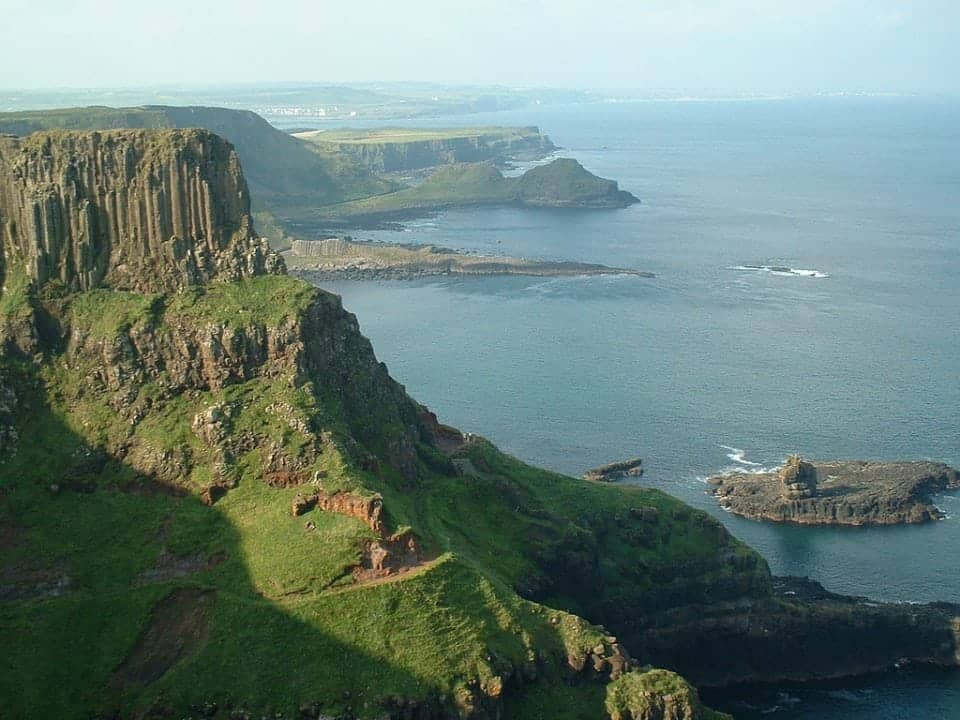
Many of these stops were and are being used in the HBO Game of Thrones series. When you travel the route, you will see small plaques with the information as to what scene was filmed in that location. You can if you want do your very own self-guided GOT tour or take one of the many tours out of Belfast or Dublin.
Giant’s Causeway
When you visit Northern Ireland’s only UNESCO World Heritage site the unique natural wonder of the Giant’s Causeway you can see pictured in your mind’s eye the Giant Finn Mccool striding those basalt cliffs and columns determined to finish that bridge to Scotland and best Bennandonner. This is one of the world’s most incredible natural wonders on the Causeway Coastal Route.
Don’t pay to use the Visitor’s Centre at the Giant’s Causeway as it only really covers parking and the Causeway is free to enter.
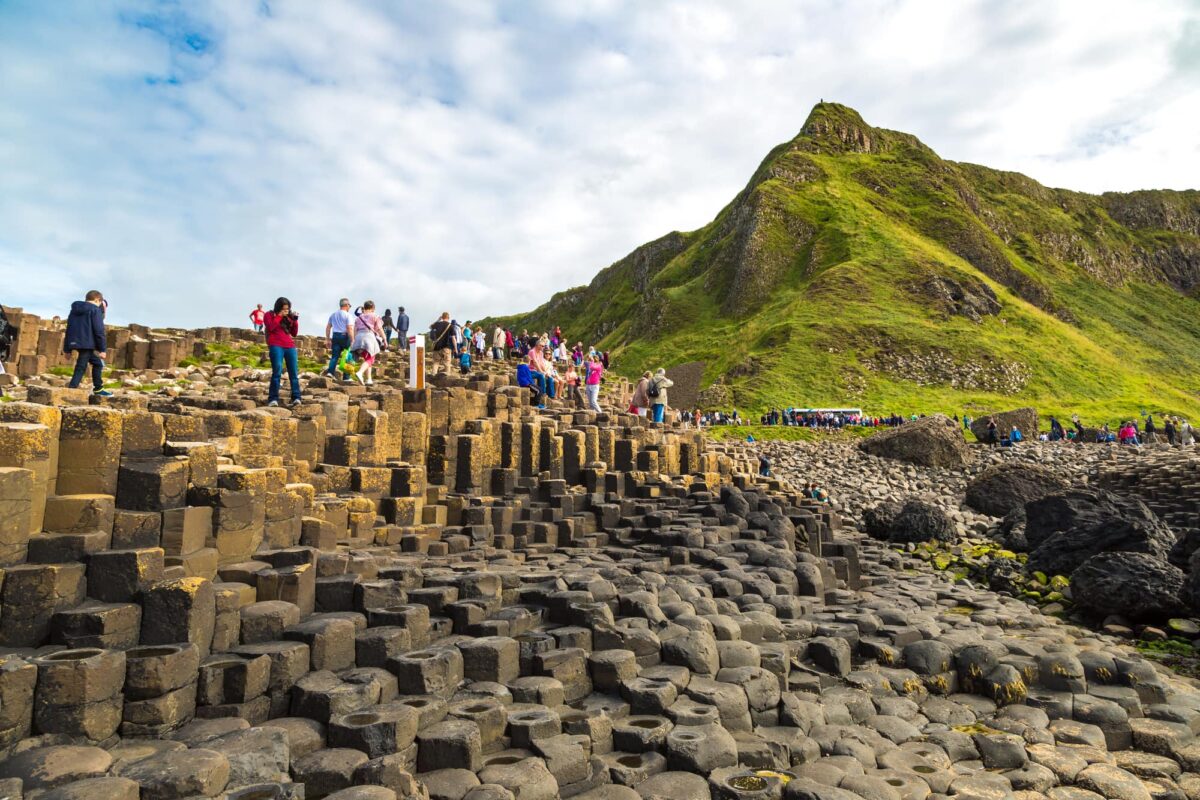
Carrick-a-Rede Rope Bridge
One of the top things to do for tourists visiting Ireland is to walk the rope bridge. The bridge itself is a crossing between N. Ireland to the Island of Carrick-a-Rede. It is made of planks, wire, rope and netting suspended 100 feet in the air and crossed 60 across the water to the Island. The rope bridge is maintained and managed by the National Trust which ensures that the bridge is safe to cross.
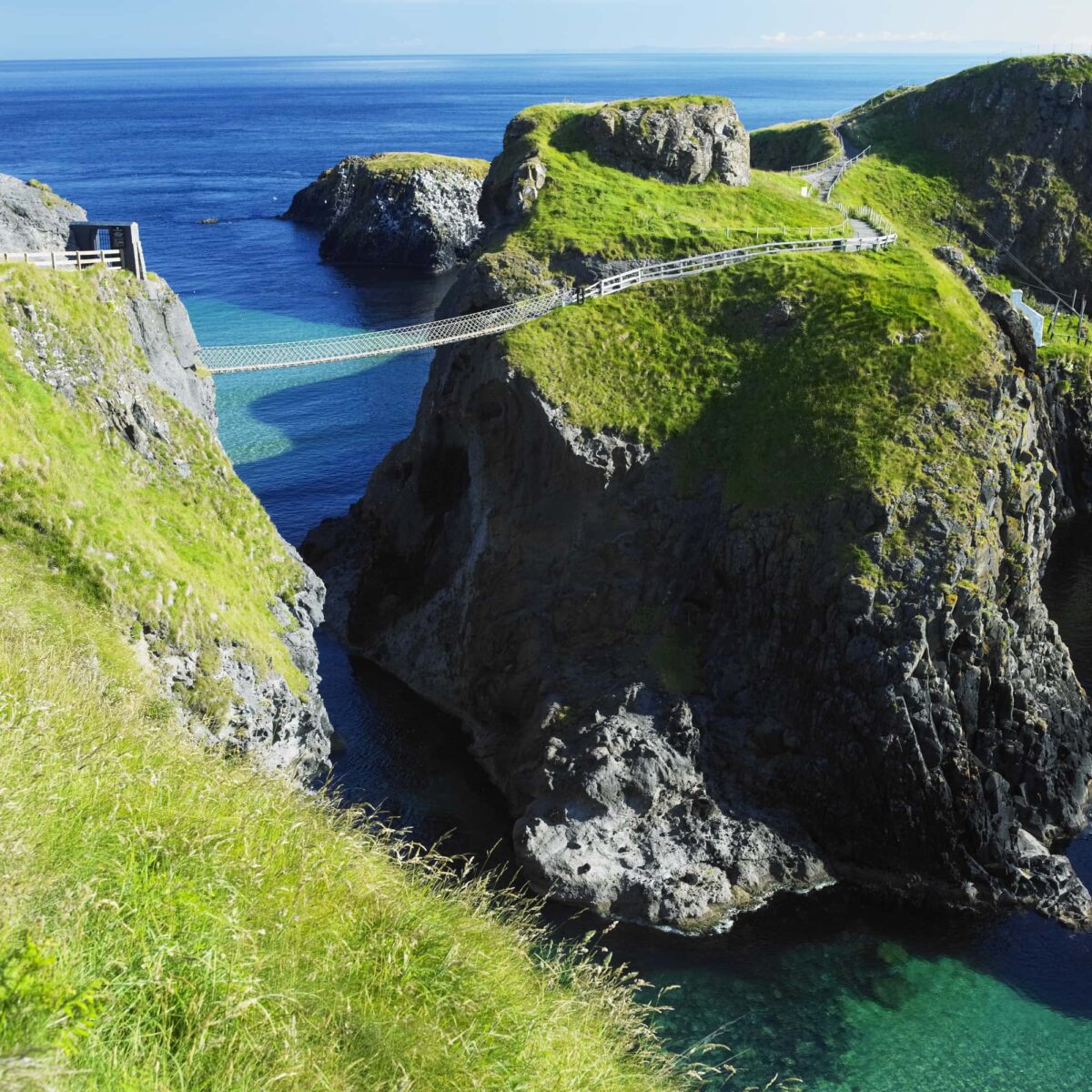
Mussenden Temple
Mussenden Temple is located in the beautiful surroundings of Downhill Demesne near Castlerock in County Londonderry. It perches dramatically on a 120 ft cliff top, high above the Atlantic Ocean on the north-western coast of Northern Ireland, offering spectacular views westwards over Downhill Strand towards Magilligan Point and County Donegal and to the east Castlerock beach towards Portstewart, Portrush and Fair Head.
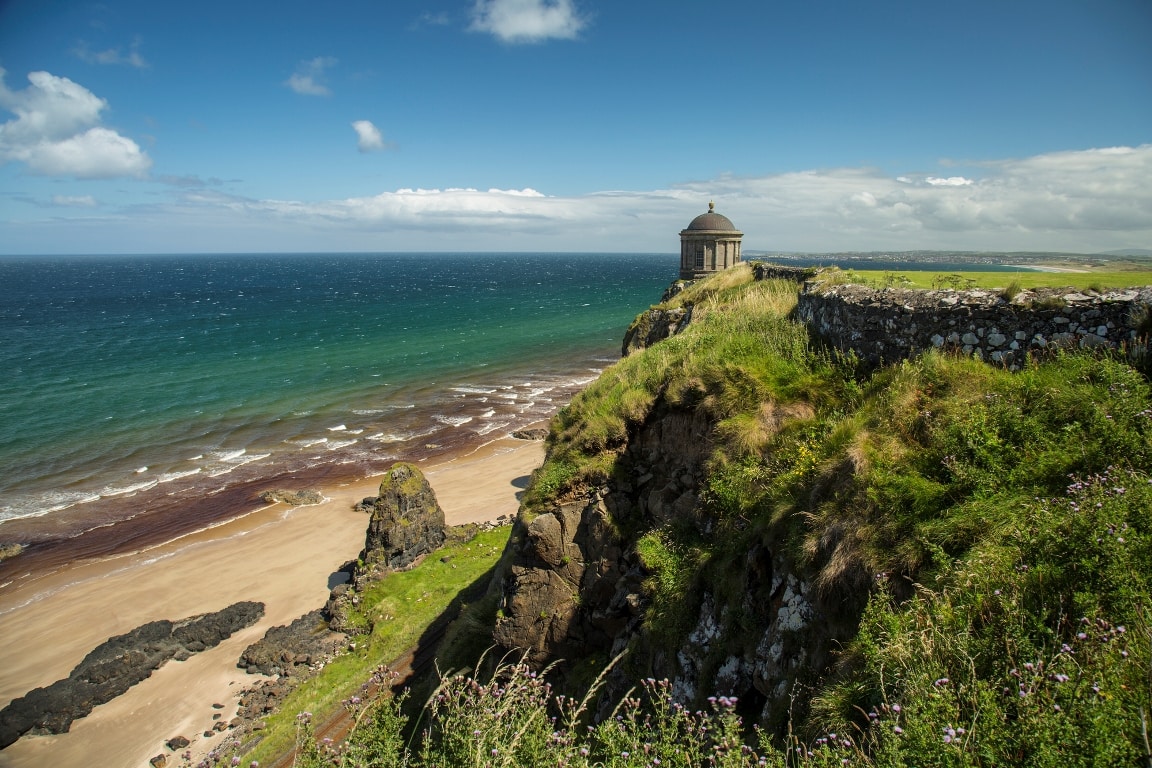
Fairhead
Standing on the cliffs at Fair Head and looking off to the west you can see the Republic whose lands in Donegal push further north than any other Irish county. Narrow lanes fenced by stone hand laid and locked into place with consummate skill. Mile-long puzzle pieces pulled from a land that couldn’t feed its own anything more than this. The Causeway Coastal Route will make poets out of all of us.
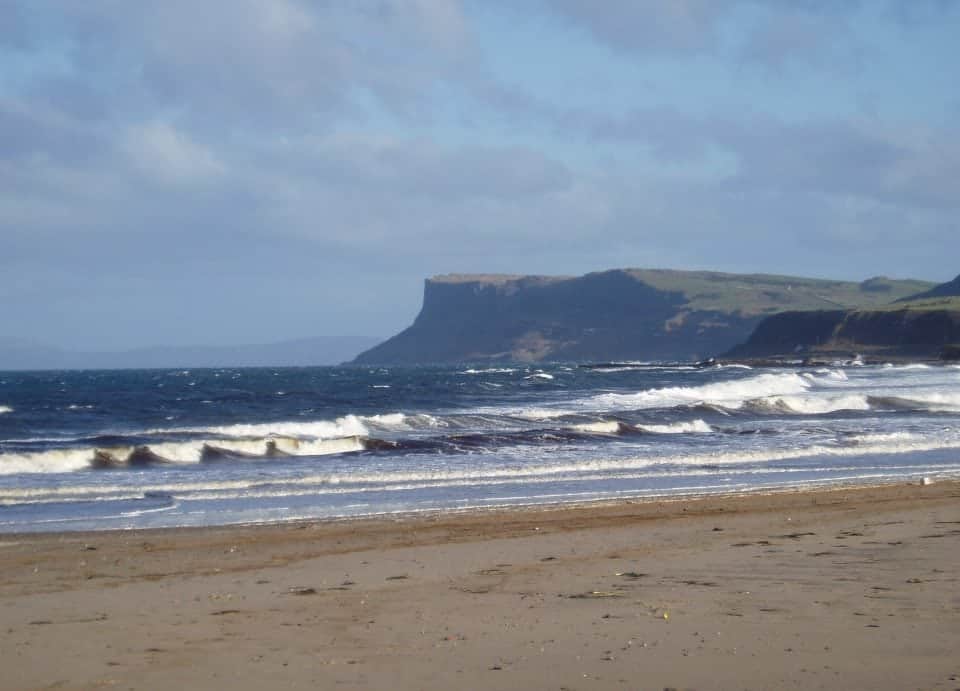
Torr Head
Rain rinsed skies meet a magical coastline as you move east into Torr Head and the Glens. Torr Head looks directly across the Irish Sea to the Mull of Kintyre. The tides of Torr Head are lethal but often it was easier to dare the crossing to Scotland as the valleys and mountains of the Glens behind were more treacherous than the tides. Follow the Torr road directly to Ballycastle.
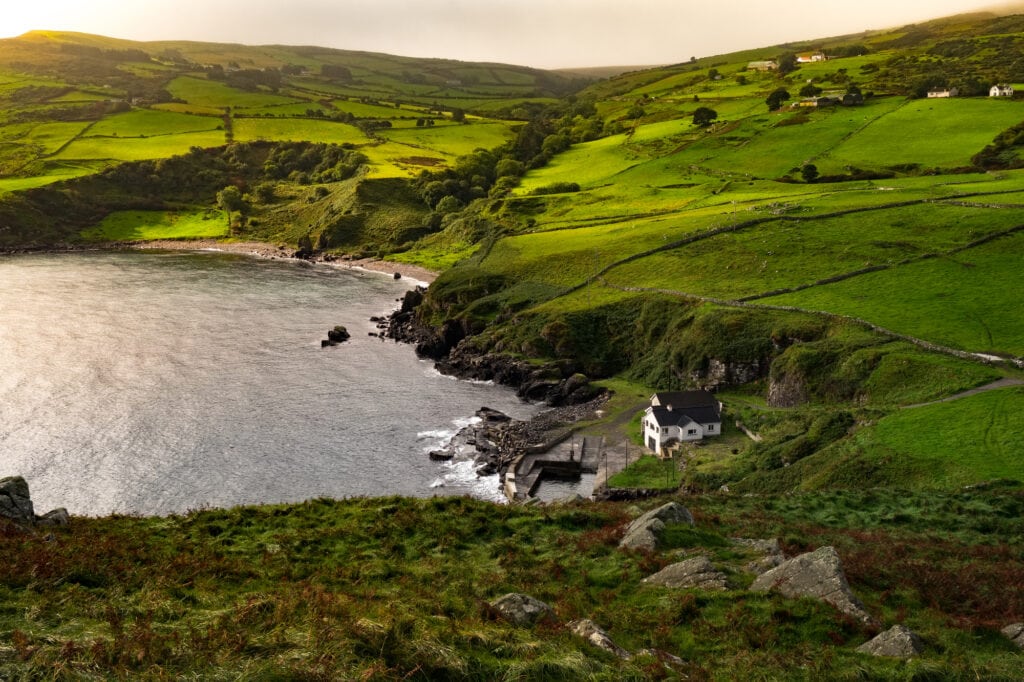
Bonamargy Friary
Just outside Ballycastle on the Whitepark Road lies the ruin of Bonamargy Friary, which is famous for its “Black Nun”. The nun wished to be buried at the entranceway of the chapel so that “she might be trodden under the feet of all who entered”. Her grave is marked by a round holed cross the only one of its kind in Ireland.
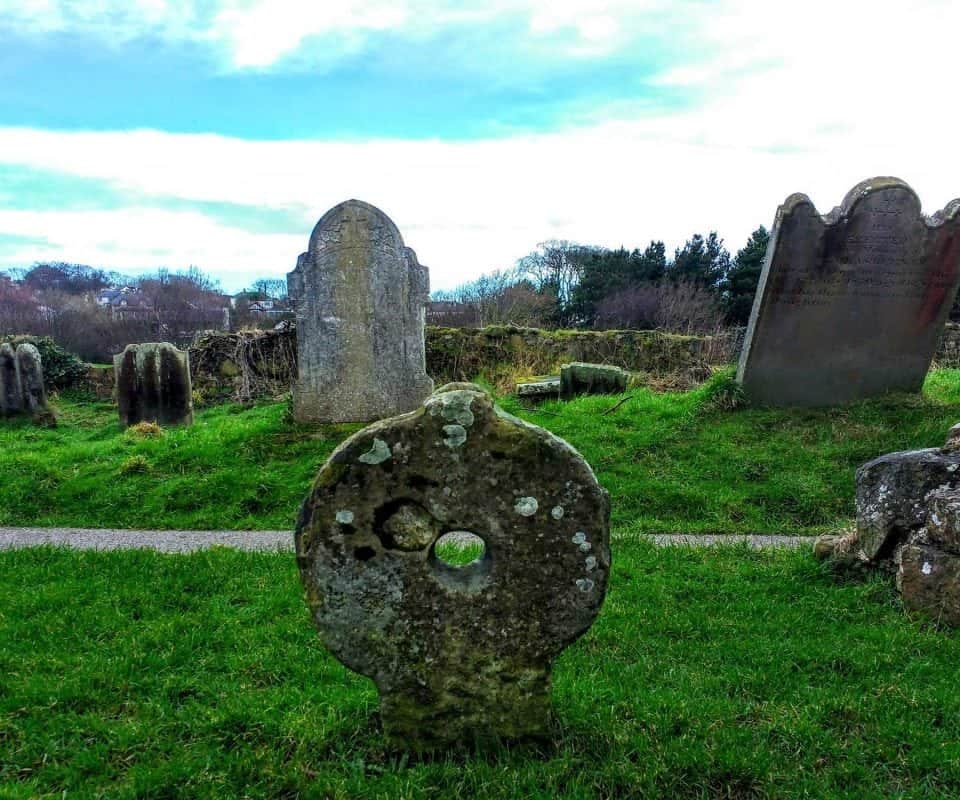
Rathlin Island
An island whose ancient history stretches back in time hundreds of years Rathlin Island has played its part in the legends of Robert the Bruce of Scotland, the massacre of Sorley Boy’s family and Viking raids. Its waters harbour shipwrecks from World War II and WWI and over 40 wrecks were lost to the cold deeps of the Sea of Moyle. Rathlin Island is where you need to go to see puffins.
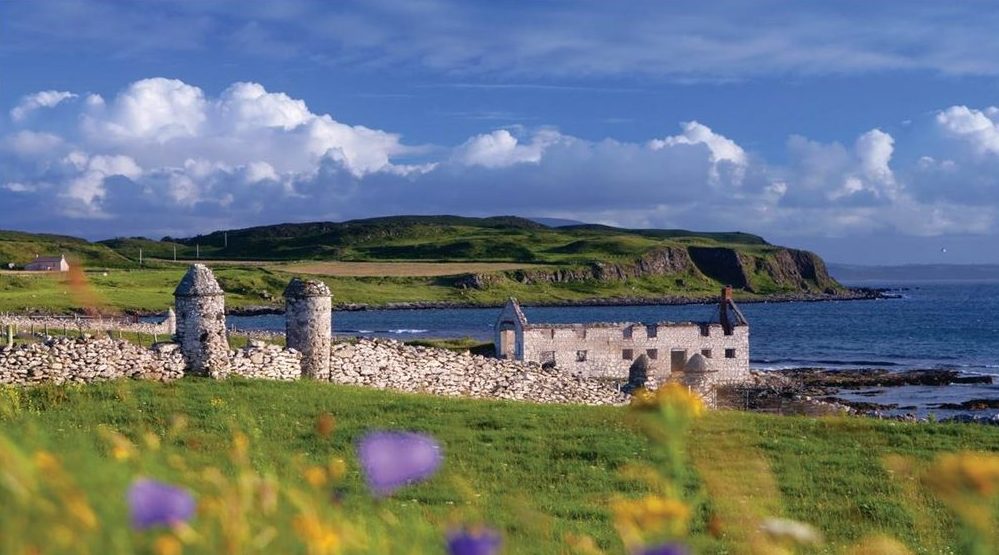
Old Bushmills Distillery
Bushmills Village is, of course, the home of Bushmills the world-famous Irish whiskey. You can’t come to the Causeway Coast and not take a tour of the Village and the distillery.
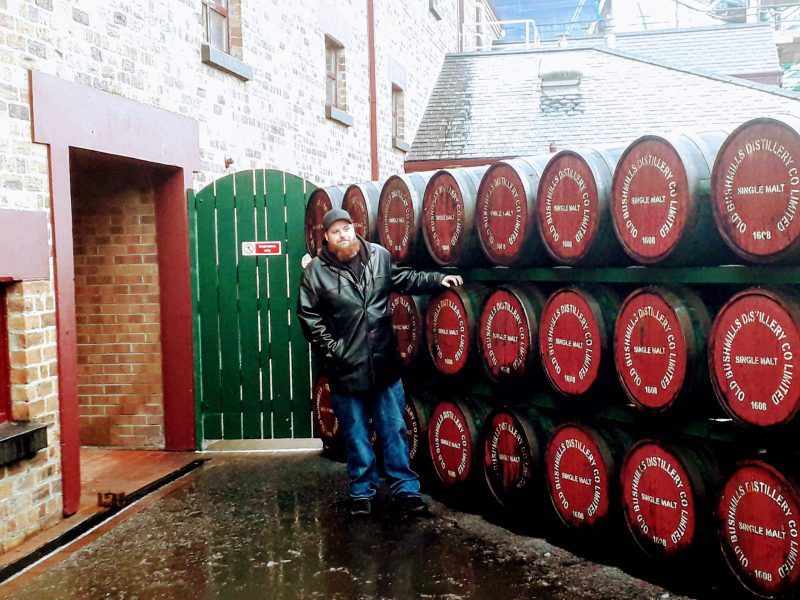
Londonderry/Derry
For me one of the best places to visit is Londonderry. Visiting Derry or Londonderry Ireland (Northern) as it’s “officially” known is something I do quite often. Londonderry is often overlooked and extremely underrated for folks visiting Ireland and yet it is one of my favourite cities in the country. Drop by the Visitor Centre where you can find information on all the tours of Derry, the Hop on Hop Off buses, Derry history and so much more.
Derry is the second biggest city in Northern Ireland borders Donegal and has close ties to the County. Its name Derry comes from the Irish word Daire which means oak forest. Derry is the only remaining intact walled city in Ireland. The old City which is walled is on the west bank of the Foyle River and is spanned by two bridges for vehicles and the pedestrian bridge named the Peace Bridge.
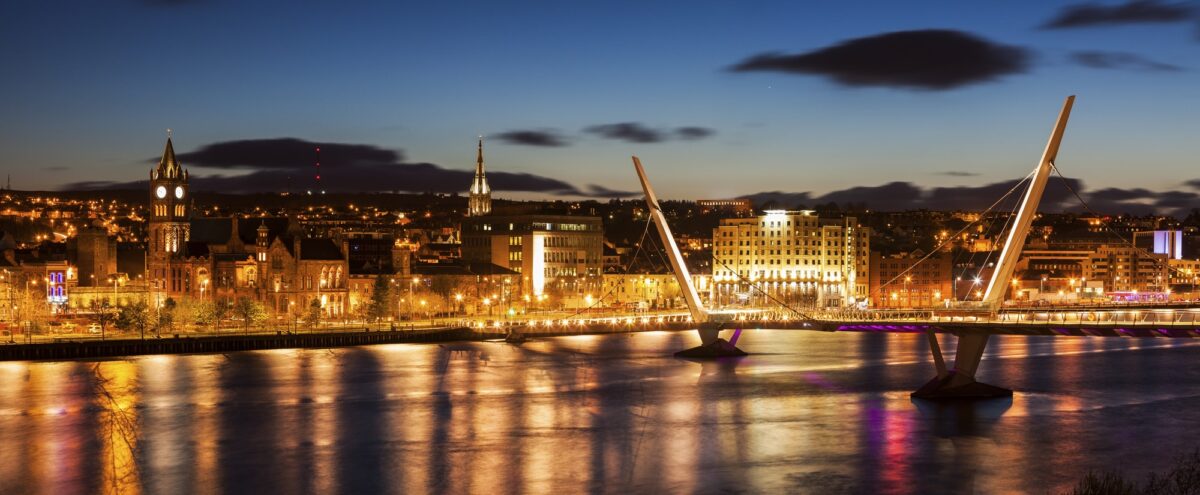
There is a lot to see and do in Londonderry the city holds a lot of history from the ancient oak forests that were plundered by the British to the Troubles and Civil Rights marches.
Walk the ancient Walls of Derry
Derry City centre is surrounded by ancient walls that were completed in 1619. The Derry Walls are 8 metres high and 9 metres thick. These are the only walls in Ireland to survive virtually intact today. The walk around the walls is approximately 1.5 kilometres long.
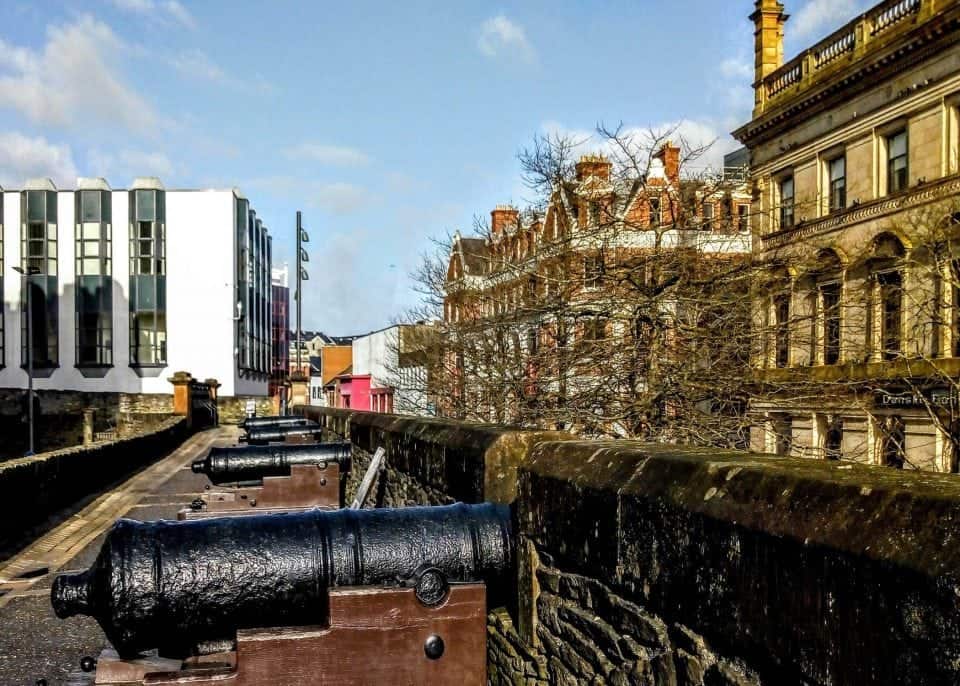
View the Derry Girls Mural
A worldwide hit TV series Derry Girls this sitcom has been an inspiration for a new generation of Irish folks that grew up during the Troubles. The reality of British Army checkpoints, bomb warnings and peace walls are all exposed in the show along with the Catholic nuns and schools attended. The Derry Girls make us laugh at the absolute absurdity of the past. The city of Derry is the filming location for the series and these days you can even take a Derry Girls tour.
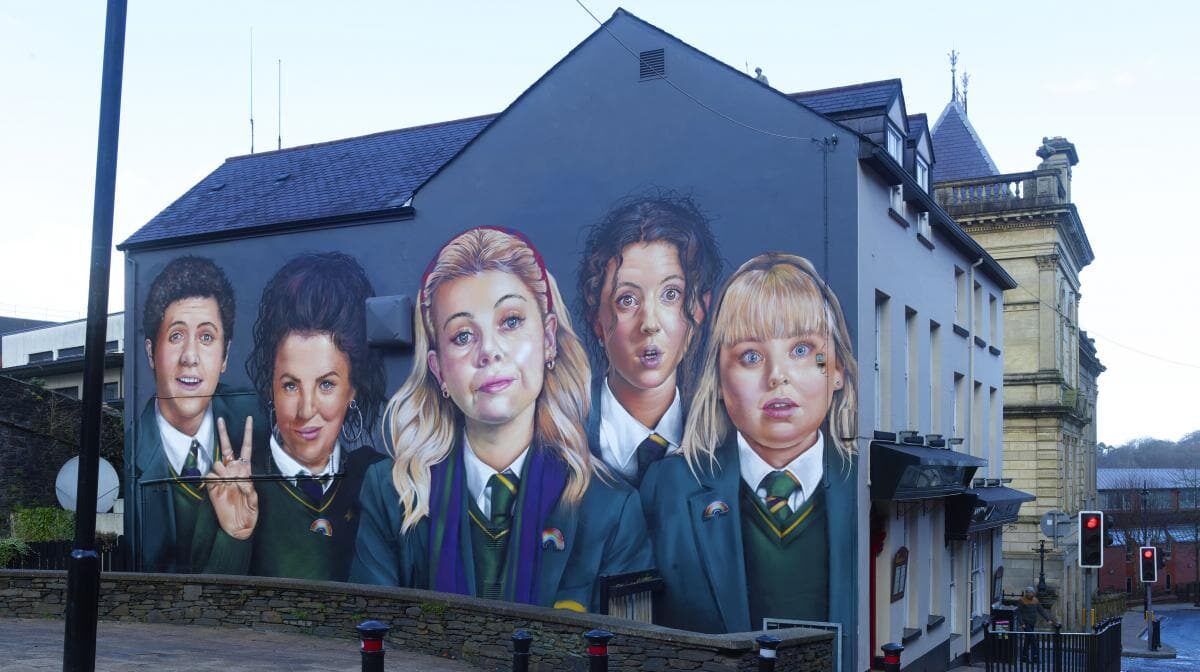
Visit the Derry Murals and Bloody Sunday Memorial
One of my favourite things to do in Northern Ireland is take visitors to see the murals both in Derry and in Belfast. Painted between 1997 and 2001 the murals are a commemoration of the events of the troubles in the Bogside. The murals include Bloody Sunday, Battle of the Bogside, Operation Motorman, and the hunger strike that took place in 1981. To see them beginning to understand that the Troubles were a civil war and that the British and IRA have a lot to answer for in the killing of hundreds of innocents is incredible.

A simple granite obelisk is surrounded by a small cast iron fence and a plaque that explains the Bloody Sunday massacre that took place here in 1972. Piles of flowers are left daily in remembrance of the event and the victims.
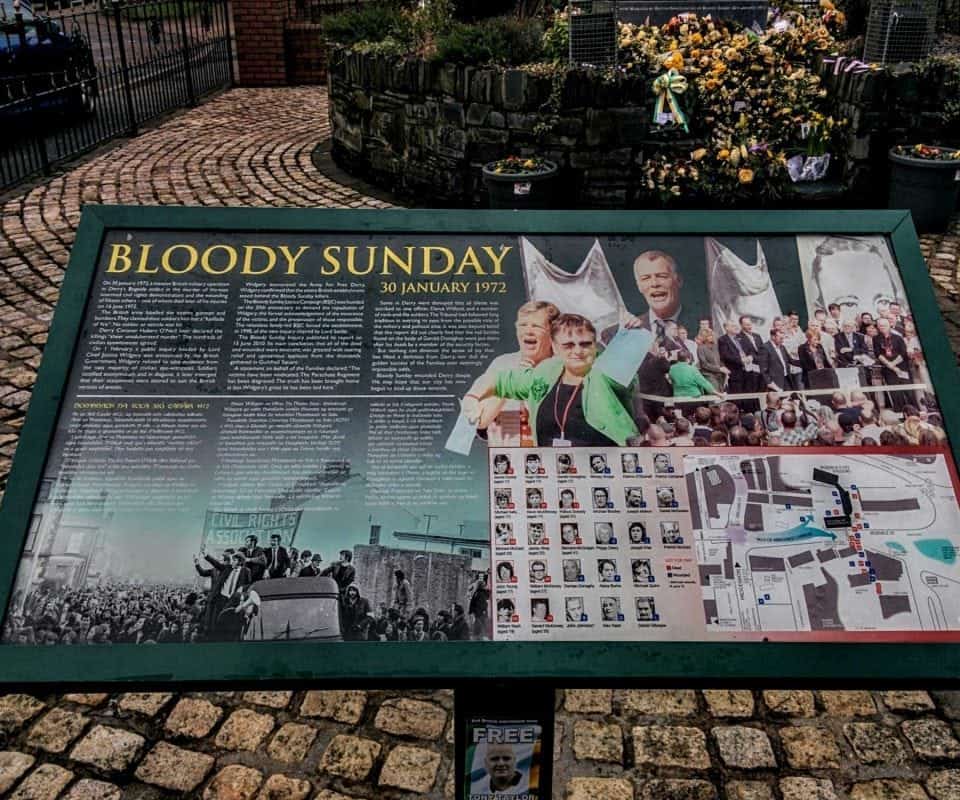
Walk across the Peace Bridge
The Derry Peace Bridge has become an integral part of Derry City and has changed the way local people use and view their city with over 3 million people having crossed it so far and many of the locals using it daily. It is a universal symbol of peace that joins the two sides of a once terribly divided city.
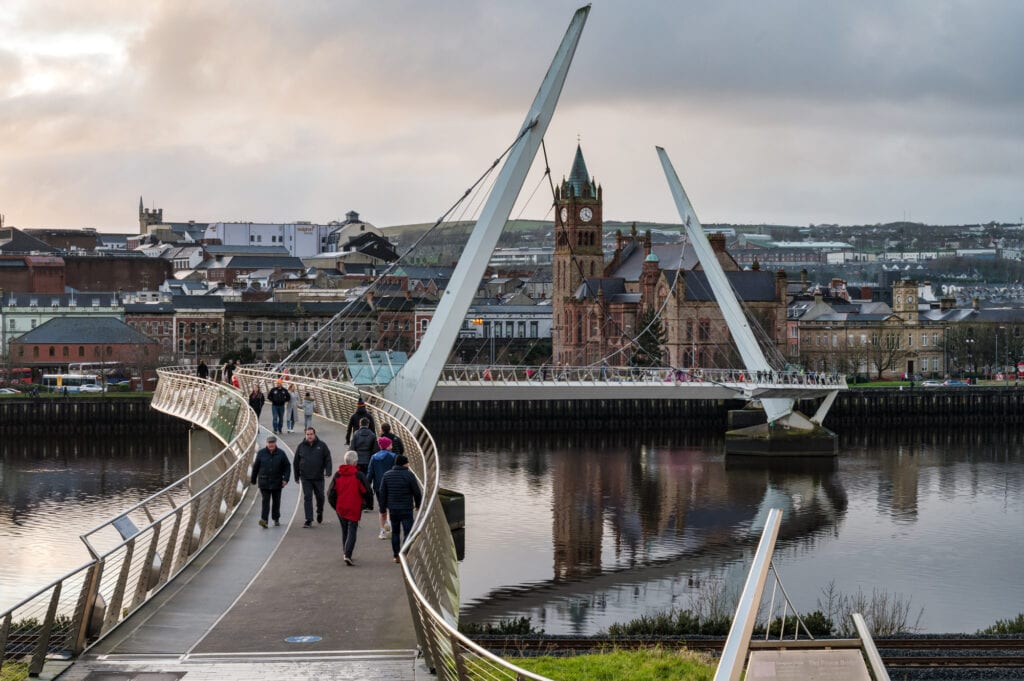
This is just a start on the beauty of Northern Ireland outside of Belfast and all the best things to do in Northern Ireland. Many folks never get to see beyond the city and the Causeway Coast or the Giant’s Causeway but there is much to see beyond Belfast and this is just a tiny portion. I’ve even put together a 101 Landmarks in Northern Ireland article so you can see how many things there are to do in Northern Ireland.
Northern Ireland is a treasure trove of tourist attractions that are sure to leave any traveller with a sense of wonder and awe. From the stunning natural beauty of the Giant’s Causeway to the fascinating history of Belfast’s Titanic Quarter, there is something for everyone in this charming corner of the world. So pack your bags, grab your camera, and get ready to explore all that Northern Ireland has to offer – just be sure to bring an umbrella because, let’s face it, this is Ireland we’re talking about!
My best advice is to rent a car, start driving and get yourself lost only then will you see the real beauty of Northern Ireland. So when are you leaving to discover Northern Ireland?
Places to visit in Northern Ireland some more reading for you:
Carrick-a-rede rope bridge – an intrepid crossing
Mussenden Temple and Downhill Demesne
Pin for later

